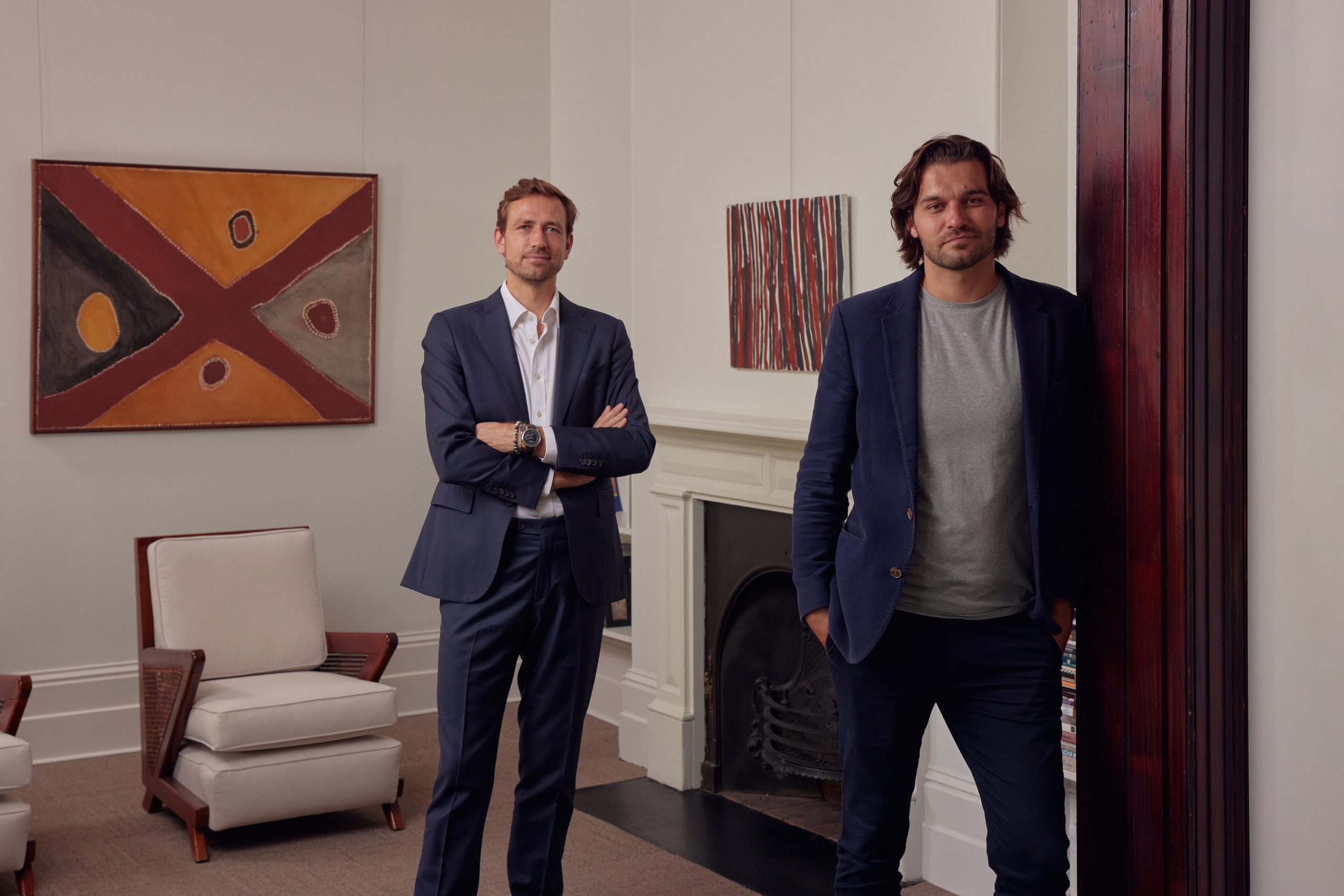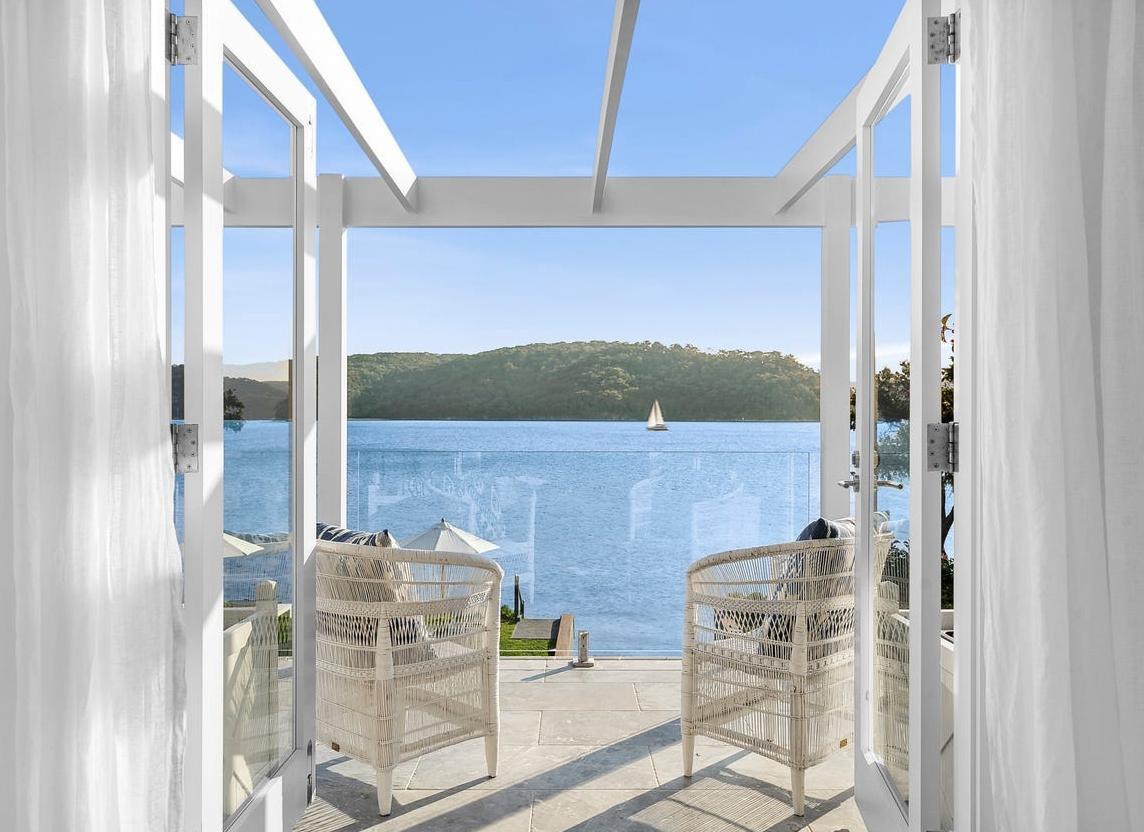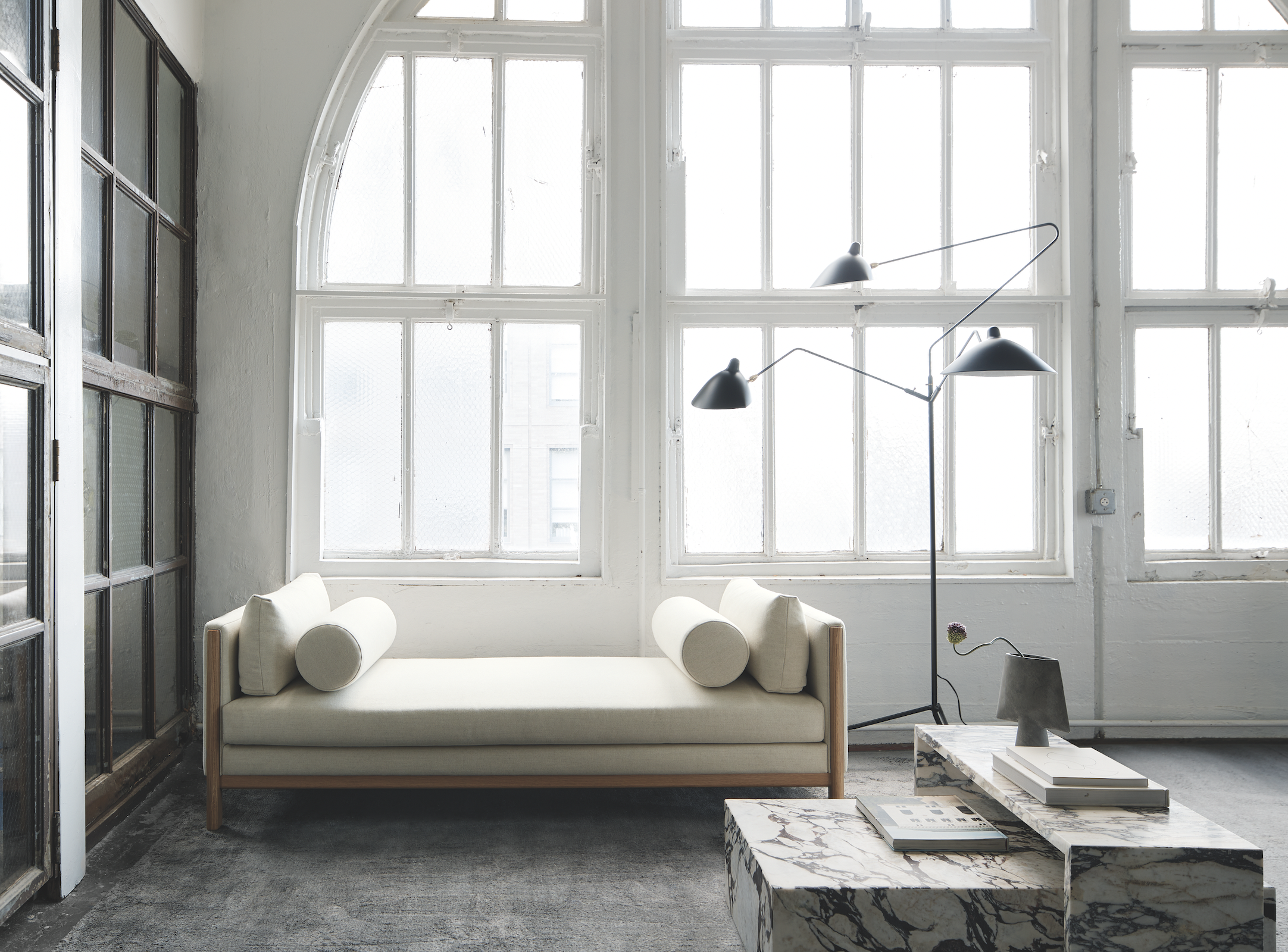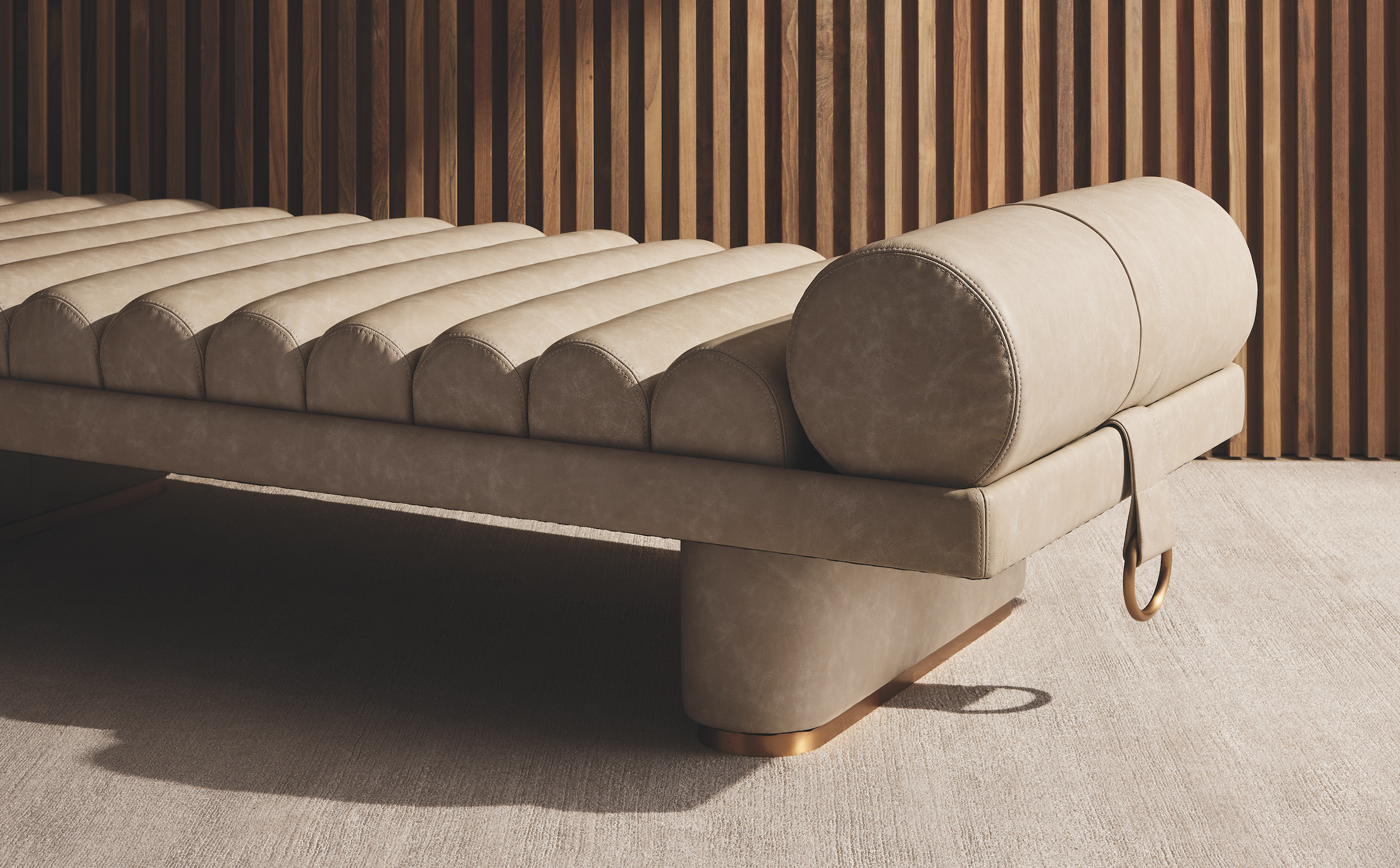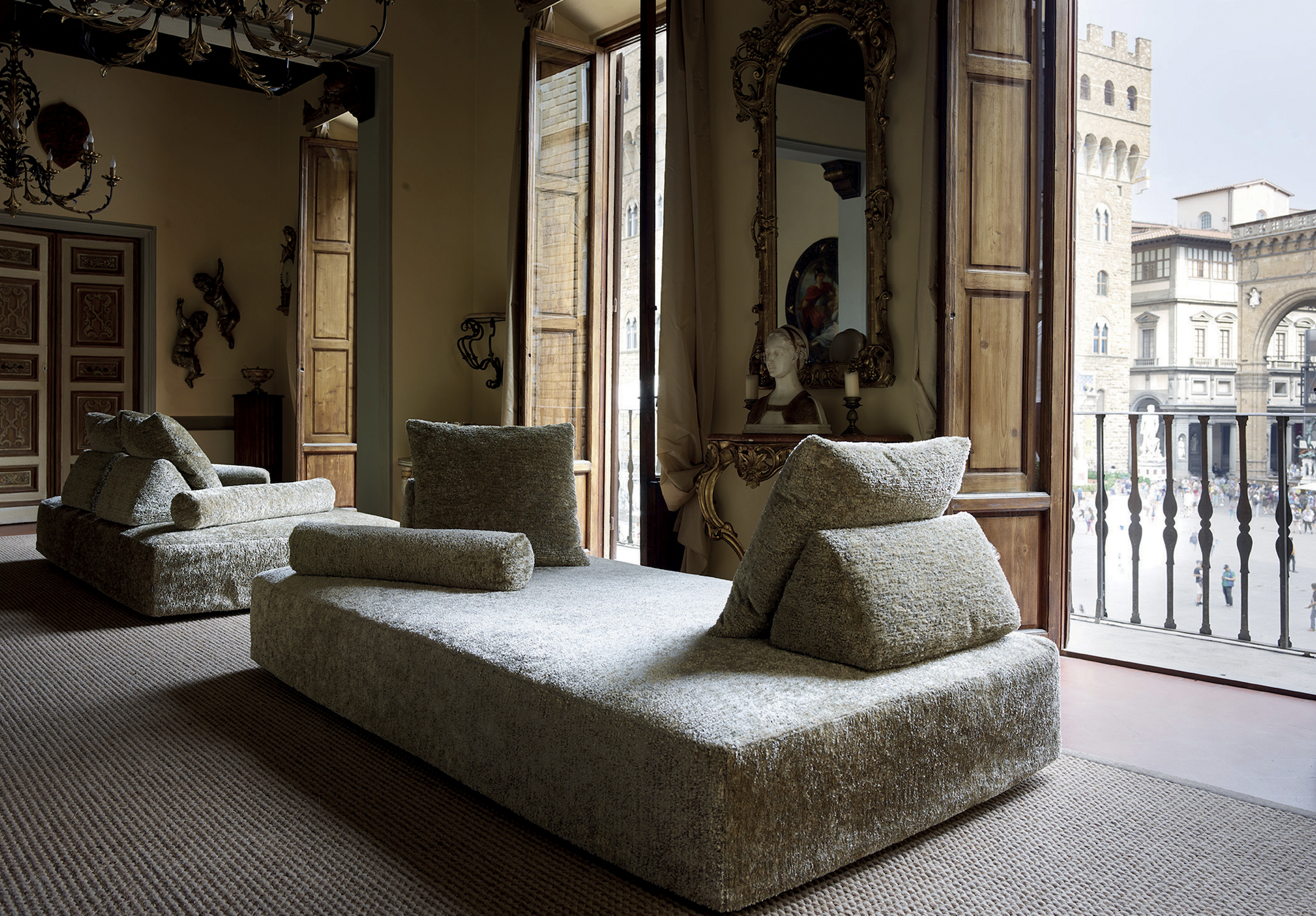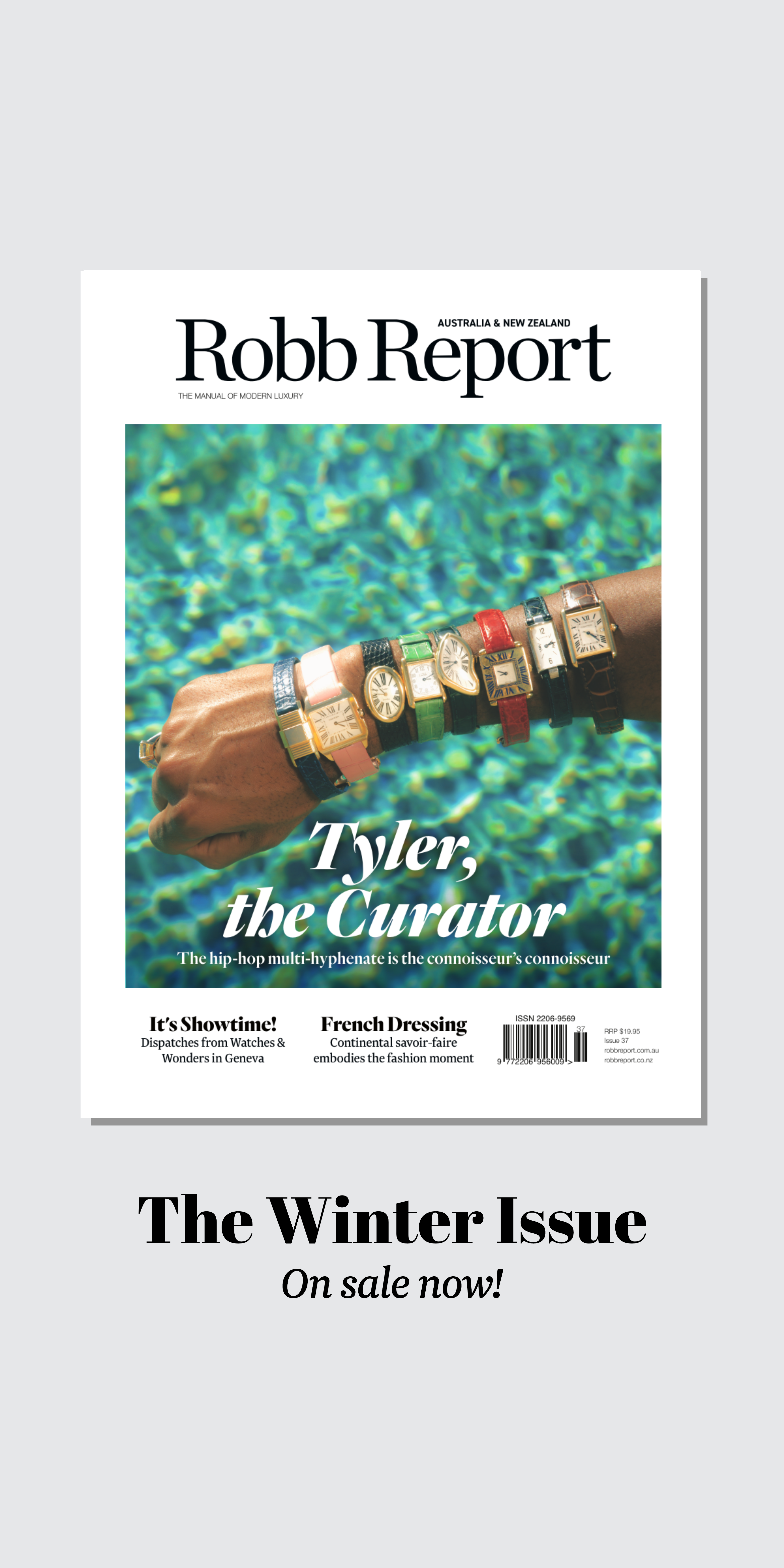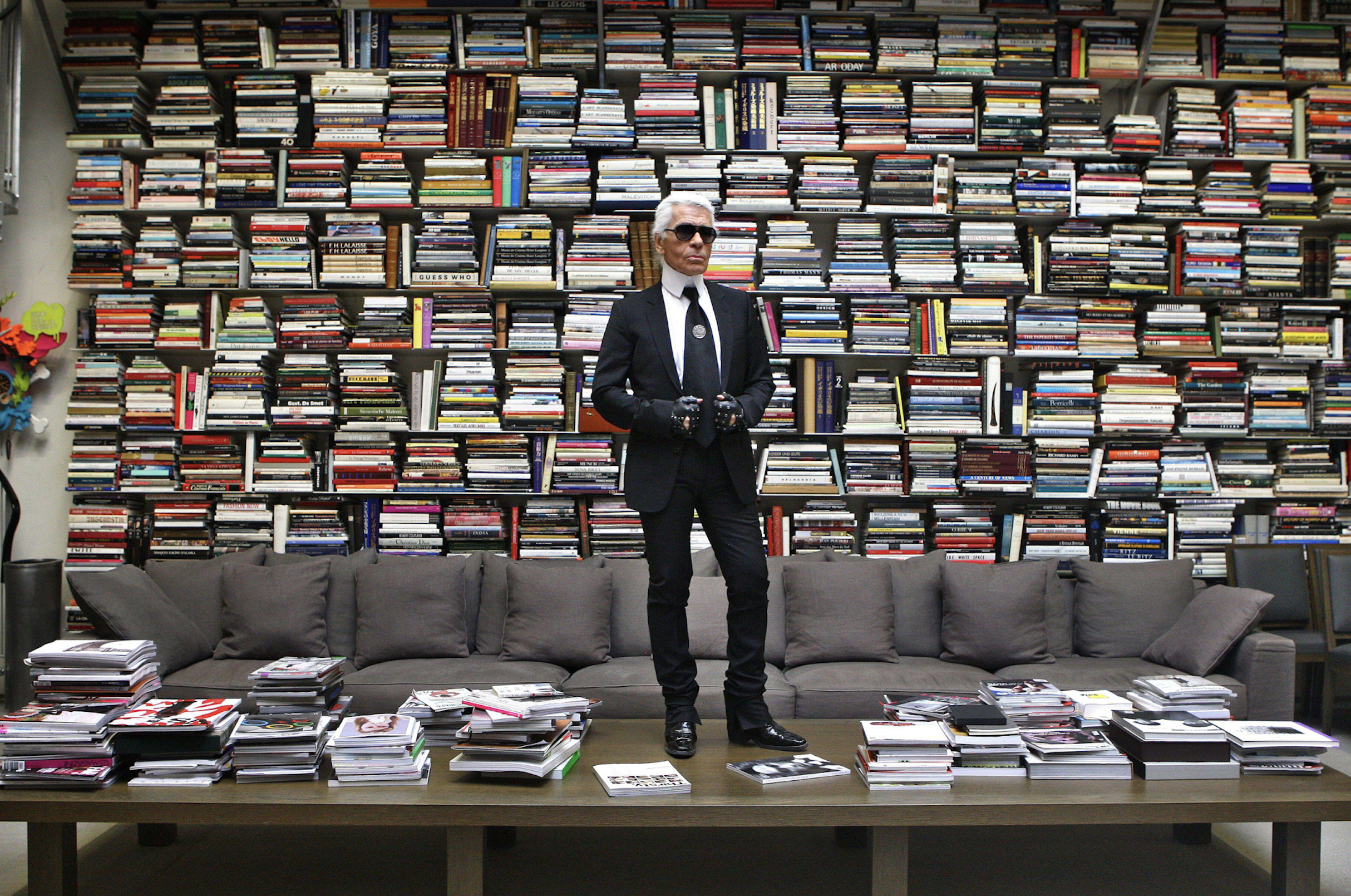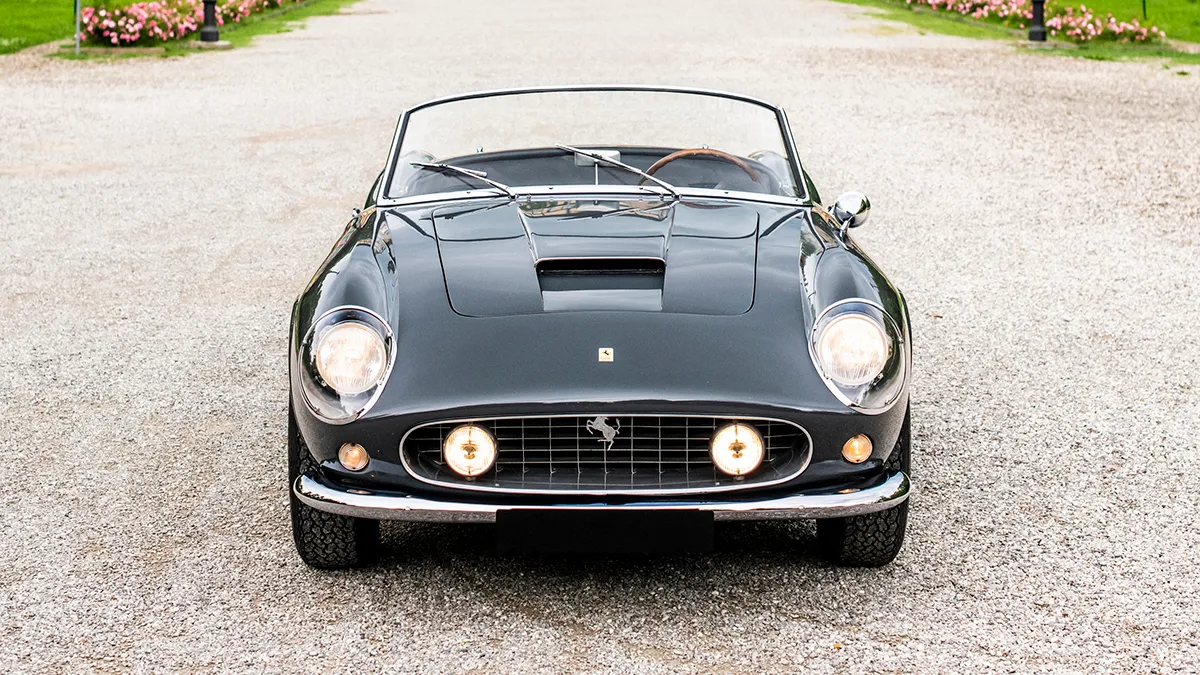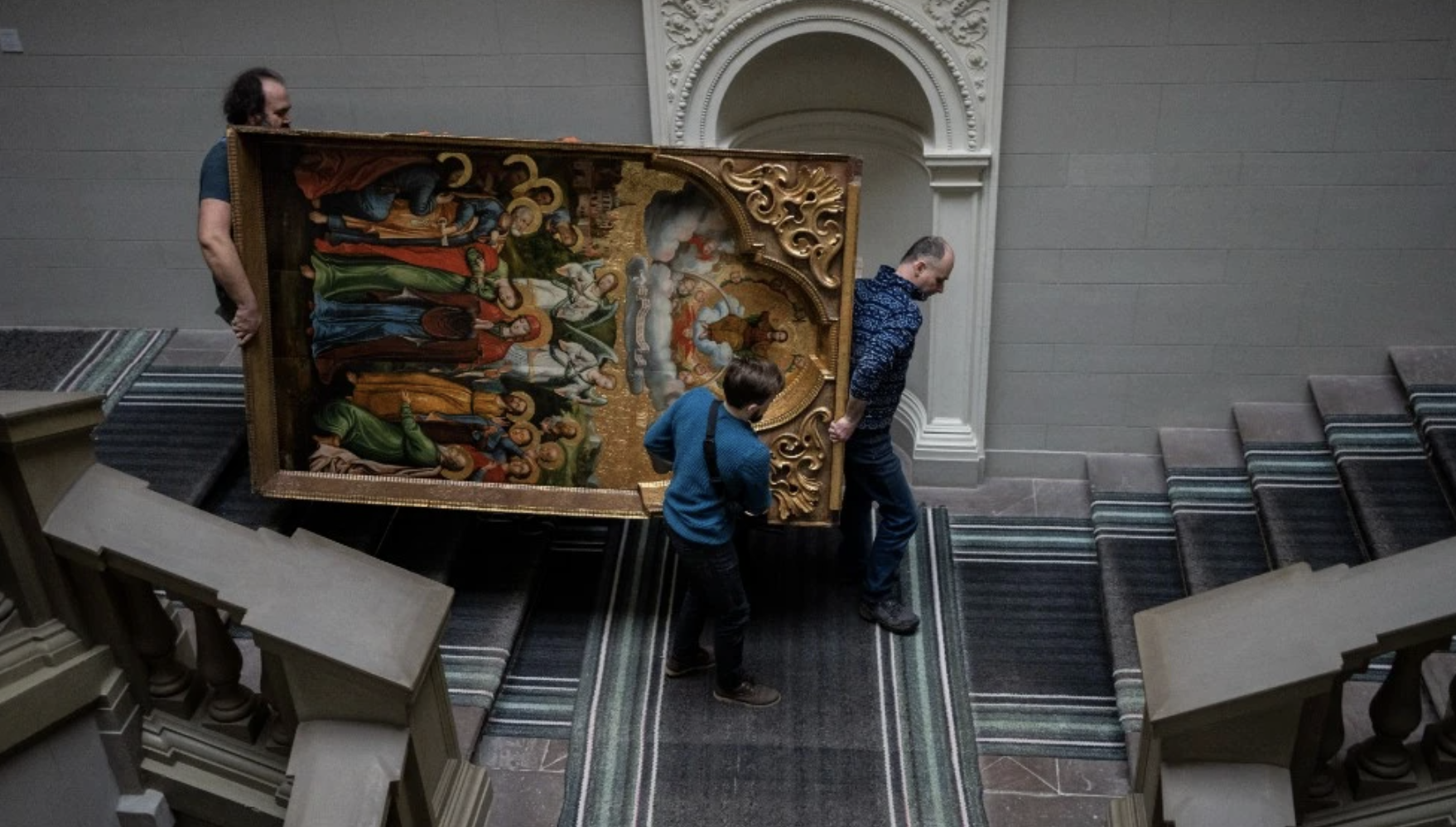
‘Don’t Film Any Soldiers, They May Shoot Us’: Inside Ukraine’s Secret Battle To Save Its Art
Art critic Waldemar Januszczak reports on the country’s astonishing mission to stop the destruction of its artistic treasures.
Related articles
I have no concrete idea how I ended up in Ukraine last week finding out about the national art and seeing how it was being saved from Russian bombs. All gods move in mysterious ways, but the gods of art are especially fickle.
It started a fortnight ago with a meeting in London of 10 of Poland’s most important museum directors. They had come over to discover why British culture appeared to be so uninterested in Polish culture. They told me their story, and I was asked about mine. So I told them.
How my mother was born in Ukraine in what were then Polish lands. How in 1939 the Russians invaded and put her on a cattle truck to Siberia. She was 16. How, when the Russians turned against the Nazis two years later, they opened up the labour camps and she walked from Siberia to the Middle East with hundreds of thousands of other newly freed Poles. How she fetched up in England. And had me. How art was my way of seeing light at the end of the tunnel.
When she was 60, I fixed it for my mother to swap her tatty “stranger’s papers” for a proper British passport, and took her back to the Ukrainian village of Lipica Dolna where she was born, some 60 miles from Lviv. The house was still there: big in her thoughts, tiny in reality. We went to Lviv, too, visited the cathedral, visited the museums. And we sobbed our eyes out together under the statue of Adam Mickiewicz, Poland’s national poet. So for me, Ukraine was personal.
Spilling all this to the Polish museum directors was causing me to tear up pathetically, so, in an effort to distract myself from me, I asked if they knew what was happening to Ukraine’s art and to Lviv’s museums? Were they safe?
They’re being looked after, piped up the director of the National Museum in Poznan, Tomasz Lecki. A couple of weeks earlier he had driven a five-ton truck to Ukraine filled with the most precious material a museum needs in times of war bubble wrap. The Ukrainians were hiding their art. They’d run out of packing materials. The Polish museums were resupplying them.
You can go and see for yourself, he added. I suppose I can, I whispered back, wishing I was as evidently Polish and brave as he was. That must be when the gods of art got involved. Because the next thing I know, Tomasz and Marta de Zuniga, the unstoppable life force from the Polish Cultural Institute who organized the event, are jointly planning my journey.
Lviv is 45 miles from the Polish border. Driving there in the dark we pass regular checkpoints, chicanes made of sandbags, flanked by homemade tank traps that look like giant metal sea urchins. The people from the Polish consulate in Lviv, who had met us at the border and got us through, tell us not to film any Ukrainian soldiers. They might shoot us.
On the drive to Lviv, giant billboards keep looming up in the dark emblazoned with stirring Slavic calls to arms. “Be ready to join the army and save Ukraine,” says a prosaic one. “Our enemies fade away, like dew in the sunshine,” says a poetic one. “Russian war ships, f* you!” says one with a clear Slavic ambition to get to the point. Every few miles, these rousing national addresses pop up out of nowhere, like stage whispers from the gods.
Lviv is exactly as I remembered it. Such a beautiful city. Cobbled and gothic, the streets untouched by yellow lines, the architecture with a fairytale mood to it that you just don’t get west of Berlin. We visit the Lviv National Art Gallery, the largest museum in Ukraine. Rumor has it that all the nation’s important art treasures have been sent to Lviv for safekeeping. So where are they?
Throughout its entire history Ukraine has been a motorway for anyone heading west or east in Europe. Whether you’re Napoleon marching on Moscow or the Golden Horde riding to Berlin, you pass through Ukraine. And all these cultures—Scythians, Tatars, Germans, Russians, Poles, French—have left their mark on the local art. The result is a wild mix of styles and influences that make Ukrainian art spectacularly varied. Now it is all under threat.

Workers move the Annunciation to the Blessed Virgin of the Bohorodchany Iconostasis in the Andrey Sheptytsky National Museum as part of safety preparations in the event of an attack in the western Ukrainian city of Lviv. Associated Press
The museum in Lviv is next door to a refugee relief center where busy volunteers hand out packages to the lucky few waving the correct ticket at them. You register online. Get a QR code in return. Wait your turn. Then pick up your package from counters scattered about the city. It’s how Western aid is being distributed in Ukraine.
The Argos way. Inside the museum it’s dark and melancholy. An art gallery without anything on the walls is a lonely place. Most of the pictures have been taken down. A few modest examples remain, but the important ones have all been hidden. No one will tell me where. Least of all the director here, a pocket-sized Tatar dynamo called Taras Voznyak, who meets me in his office.
Voznyak is a card. He starts off by complaining about the Russian fighting forces being sent to Ukraine. They’re young idiots, he says dismissively. They don’t know what they’re doing. Especially when compared with hardened veterans like him and Lecki; men who know how to use a gun. “Old heroes,” I quip. “Middle-aged heroes,” he hisses back with a crooked Tatar smile.
Propped up on his cupboard is a 19th-century painting of an earlier Ukrainian war showing a mounted Chechen waving the decapitated head of a Russian at us. “It pleases me,” he answers when I ask him why he’s put it there. Not in a million years can I imagine the director of Tate Britain or the National Portrait Gallery being as up for a scrap as Voznyak. Same job. Completely different species.
I tell him that the picture I remember best in his museum, the one I enjoyed most on my visit with my mother, was The Money Changers by Georges de la Tour, which shows a mysterious financial transaction set in gripping baroque darkness. De la Tours are rare. The Money Changers is one of his masterpieces. Can I see it? No. It’s hidden. And no, he won’t tell me if all of Ukraine’s art treasures are now in Lviv. It’s a state secret. What he can show me is where the de la Tour used to hang.
So we march through the darkened museum to a faded wall on which a shadow of the great painting is still visible on the wallpaper. And the two of us stand in front of the empty spot in silence, two middle-aged art lovers, struck simultaneously with sadness.
On the way back, an air raid siren starts up. Voznyak ignores it and takes me, instead, into the museum garden to show me his sandbags. Don’t write about anything you see in the museum and its basements, he twinkles.
He is annoyed that people in the West seem to have forgotten that the war with the Russians started in 2014 with the invasion of Crimea. The present fight is just the latest episode. So Ukraine has had plenty of time to prepare plans and regulations for moving its national art to safety. Yes, many of the art treasures from Kyiv, Kharkiv and Dnipro have come to Lviv. But many are hidden elsewhere. Where the Russians won’t find them.
Outside the gallery, it’s lunchtime. Time to take a stroll through beautiful Lviv. Across the city, various windows of various public buildings have been boarded up. The stained glass of the cathedral, where I took my mum, has been wrapped in shiny protective sheets. The statues surrounding the church look as if they’ve been bandaged up by a doctor. That’s where the bubble wrap went.
Everywhere you look there’s the Ukrainian flag, with its Van Gogh colours of sky blue and corn yellow, such a catchy design, playing such a crucial role in rousing the populace. Every flag is a shortcut to the issue, an immediate visual reminder of what Ukrainians are living through. It’s the power of art.
Lviv’s magnificent opera house has become a poster site for heroic imagery. Those people waving flags at us from a tiny speck of land in the Black Sea are the defenders of Snake Island who on the first day of the invasion famously refused to surrender to Russian warships. Another poster shows a pale figure in a pilot uniform they call “the Ghost of Kyiv,” the legendary Ukrainian fighter pilot who is rumoured to have brought down 48 Russian planes since the war began. Some believe he exists. Others do not. Either way, the Ghost of Kyiv is doing his bit to inspire his people.

Workers move a baroque sacred art piece in the Andrey Sheptytsky National Museum as part of safety preparations in the event of an attack on Lviv. Associated Press
So, of course, is Ukrainian art. It’s what art does in times of war. It rallies the national spirit and focuses it.
That’s why the entire collection of our own National Gallery was moved to safety in a cave in Wales during the Second World War. It’s why Henry Moore stopped carving modernist Madonnas during the Blitz and began drawing huddled survivors hiding from the bombs in the tunnels of the London Underground. When things grow dark, art gets real. And it suddenly matters more.
Back at the museum, Voznyak introduces me to two artists who fled last month from Kyiv and are now living at the museum. I’ve heard of artists in residence before. But they don’t actually live on site like Vlada Ralko and Volodymyr Budnikov, who have moved into an unused gallery with a huge bed and a cat. All day long they sit in their patched-up bedroom making art about the conflict.
Budnikov is usually an abstract artist, he insists. Now he’s painting skeletons, bombs, mutations, explosions. Putin has done terrible things, I mutter in sympathy. Not Putin, he snarls back. All Russians. They’re not human. This is what they do.
Voznyak reappears. He has organized a car that’s going to drive us out of Lviv to a secret store where the museum keeps some of its art in a disused monastery. I can go and see it. We drive for an hour and a half, and eventually arrive at a crumbling clerical prison surrounded by a high wall. It’s late. The formidable Ukrainian woman who runs the outpost frogmarches me through corridor after corridor packed to the rafters with icons thrown away by the Soviet soldiers when they annexed Ukraine in 1939. Thousands of them. Upstairs, I’m led through another never-ending hoard of baroque church sculptures, enough to fill 10 normal museums. This, she waves, is a fraction of what they have.
The next morning, back in the city, I finally get to meet the Polish consul Eliza Dzwonkiewicz, the only foreign consul left in Lviv. The rest have gone. So have all the ambassadors in Kyiv except the one from Poland and the papal nuncio from the Vatican.
Dzwonkiewicz takes us for coffee in the town, dressed in what looks like snazzy urban sportswear, with only the Polish consulate badge on her arm confirming her rank. When the war broke out, she explains, she had these outfits specifically made for the consular staff. War is not a time for decorative diplomat wear.
I take a final stroll around Lviv’s beautiful central square. “This is our land. We won’t give it up,” says one blue-and-gold billboard. “Don’t run away. Defend,” urges another. On a particularly striking poster, a huge expanse of red represents Russia, while a tiny patch of yellow represents Ukraine. “David and Goliath,” shouts the text. “Remember What Happened.”
Subscribe to the Newsletter
Recommended for you
A Secondary Eye
Seeking bang for your artwork bucks? A new private gallery in Sydney is here to help investors.
May 24, 2024
Everybody Loves Naomi
Fashion fans adore her. And so do we. Lucky, then, that a new exhibition is paying homage to the undisputed queen of the catwalk.
By Joseph Tenni
June 22, 2024
You may also like.
By Josh Bozin
24/07/2024
You may also like.
5 Lounge Chairs That Add Chic Seating to Your Space
Daybeds, the most relaxed of seating solutions, offer a surprising amount of utility.
Chaise longue, daybed, recamier, duchesse brisée—elongated furniture designed for relaxing has a roster of fancy names. While the French royal court of Louis XIV brought such pieces to prominence in fashionable European homes, the general idea has been around far longer: The Egyptian pharaohs were big fans, while daybeds from China’s Ming dynasty spurred all those Hollywood Regency fretwork pieces that still populate Palm Beach living rooms. Even Mies van der Rohe, one of design’s modernist icons, got into the lounge game with his Barcelona couch, a study of line and form that holds up today.
But don’t get caught up in who invented them, or what to call them. Instead, consider their versatility: Backless models are ideal in front of large expanses of glass (imagine lazing on one with an ocean view) or at the foot of a bed, while more structured pieces can transform any corner into a cozy reading nook. Daybeds may be inextricably linked to relaxation, but from a design perspective, they put in serious work.
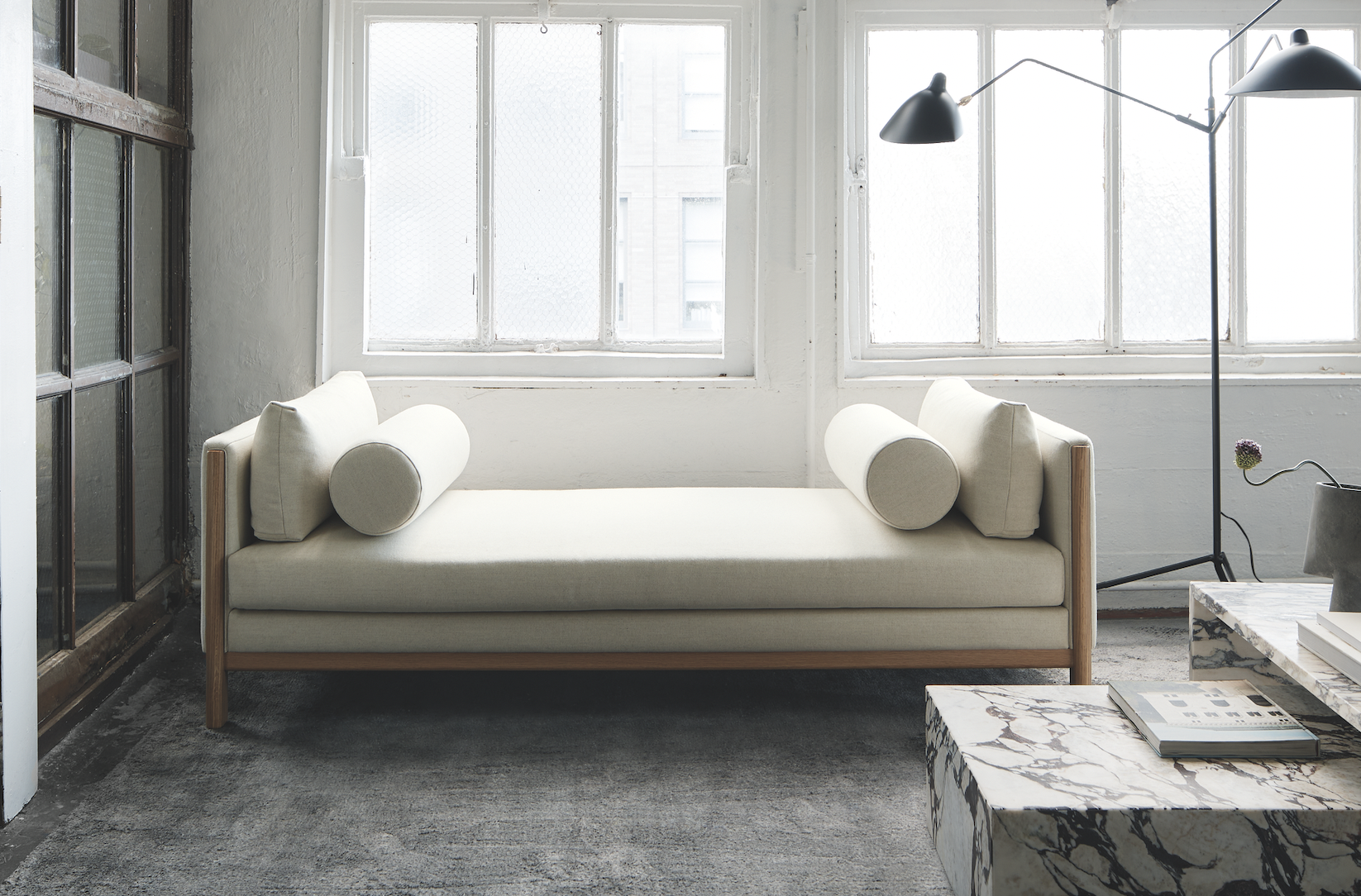
Emmy, Egg Collective
In designing the Emmy chaise, the Egg Collective trio of Stephanie Beamer, Crystal Ellis and Hillary Petrie, who met as students at Washington University in St. Louis, aimed for versatility. Indeed, the tailored chaise looks equally at home in a glass skyscraper as it does in a turn-of-the-century town house. Combining the elegance of a smooth, solid oak or walnut frame with the comfort of bolsters and cushioned upholstery or leather, it works just as well against a wall or at the heart of a room. From around $7,015; Eggcollective.com
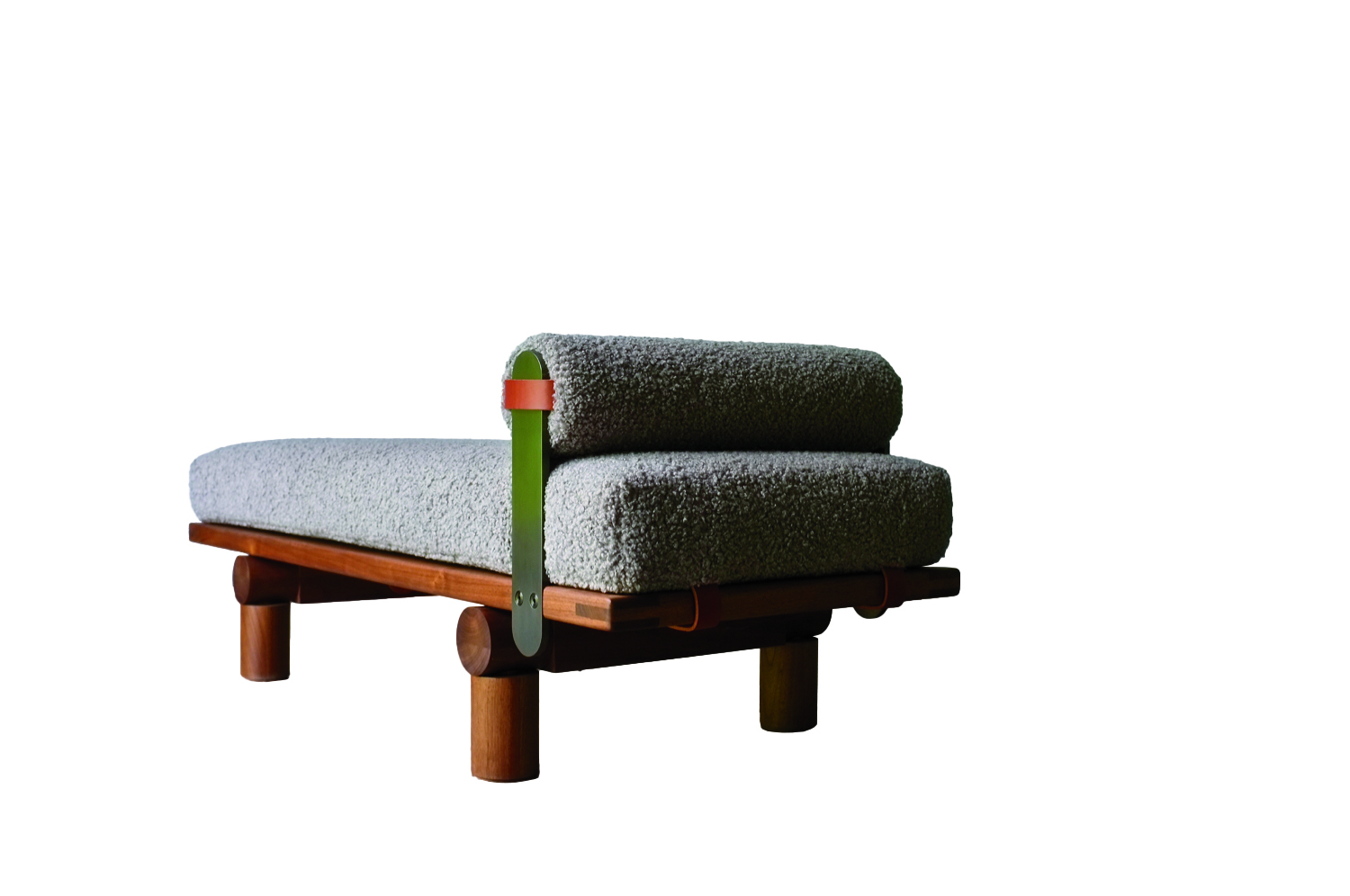 Plum, Michael Robbins
Plum, Michael Robbins
Woodworker Michael Robbins is the quintessential artisan from New York State’s Hudson Valley in that both his materials and methods pay homage to the area. In fact, he describes his style as “honest, playful, elegant and reflective of the aesthetic of the Hudson Valley surroundings”. Robbins crafts his furniture by hand but allows the wood he uses to help guide the look of a piece. (The studio offers eight standard finishes.) The Plum daybed, brought to life at Robbins’s workshop, exhibits his signature modern rusticity injected with a hint of whimsy thanks to the simplicity of its geometric forms. Around $4,275; MichaelRobbins.com
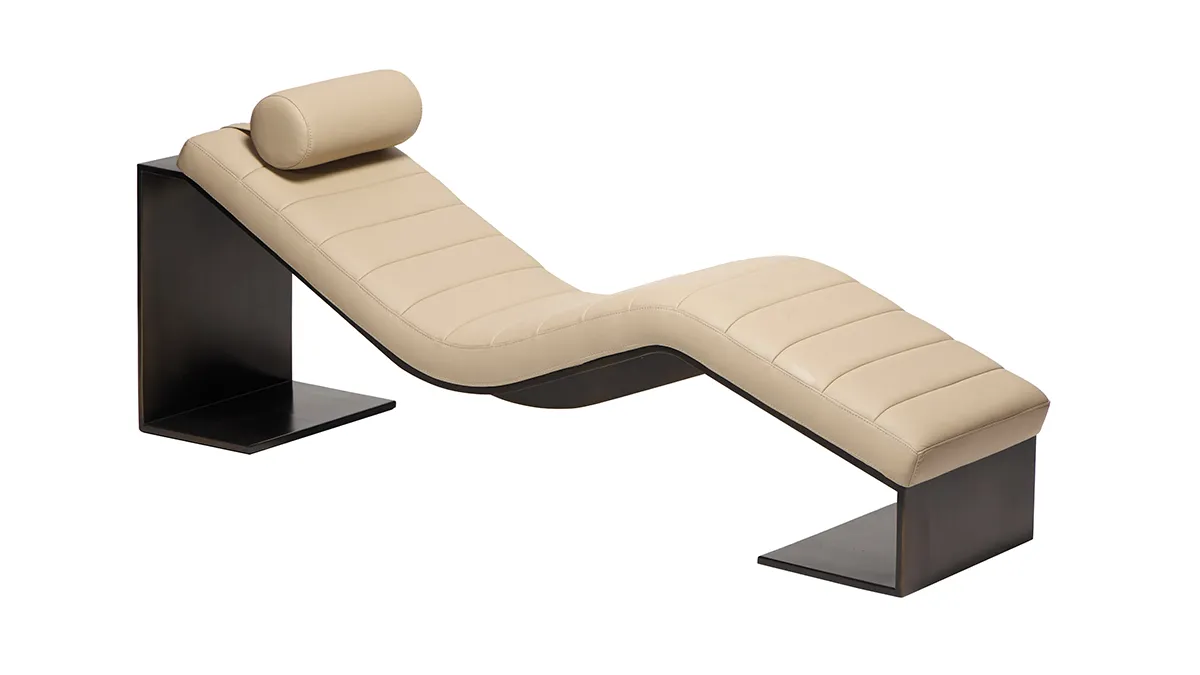
Kimani, Reda Amalou Design
French architect and designer Reda Amalou acknowledges the challenge of creating standout seating given the number of iconic 20th-century examples already in existence. Still, he persists—and prevails. The Kimani, a bent slash of a daybed in a limited edition of eight pieces, makes a forceful statement. Its leather cushion features a rolled headrest and rhythmic channel stitching reminiscent of that found on the seats of ’70s cars; visually, these elements anchor the slender silhouette atop a patinated bronze base with a sure-handed single line. The result: a seamless contour for the body. Around $33,530; RedaAmalou
Dune, Workshop/APD
From a firm known for crafting subtle but luxurious architecture and interiors, Workshop/APD’s debut furniture collection is on point. Among its offerings is the leather-wrapped Dune daybed. With classical and Art Deco influences, its cylindrical bolsters are a tactile celebration, and the peek of the curved satin-brass base makes for a sensual surprise. Associate principal Andrew Kline notes that the daybed adeptly bridges two seating areas in a roomy living space or can sit, bench-style, at the foot of a bed. From $13,040; Workshop/ APD
Sherazade, Edra
Designed by Francesco Binfaré, this sculptural, minimalist daybed—inspired by the rugs used by Eastern civilizations—allows for complete relaxation. Strength combined with comfort is the name of the game here. The Sherazade’s structure is made from light but sturdy honeycomb wood, while next-gen Gellyfoam and synthetic wadding aid repose. True to Edra’s amorphous design codes, it can switch configurations depending on the user’s mood or needs; for example, the accompanying extra pillows—one rectangular and one cylinder shaped— interchange to become armrests or backrests. From $32,900; Edra
You may also like.
By Josh Bozin
24/07/2024
22/07/2024
Watches & Wonders 2024 Showcase: Hermès
We head to Geneva for the Watches & Wonders exhibition; a week-long horological blockbuster featuring the hottest new drops, and no shortage of hype.
With Watches & Wonders 2024 well and truly behind us, we review some of the novelties Hermès presented at this year’s event.
—
HERMÈS
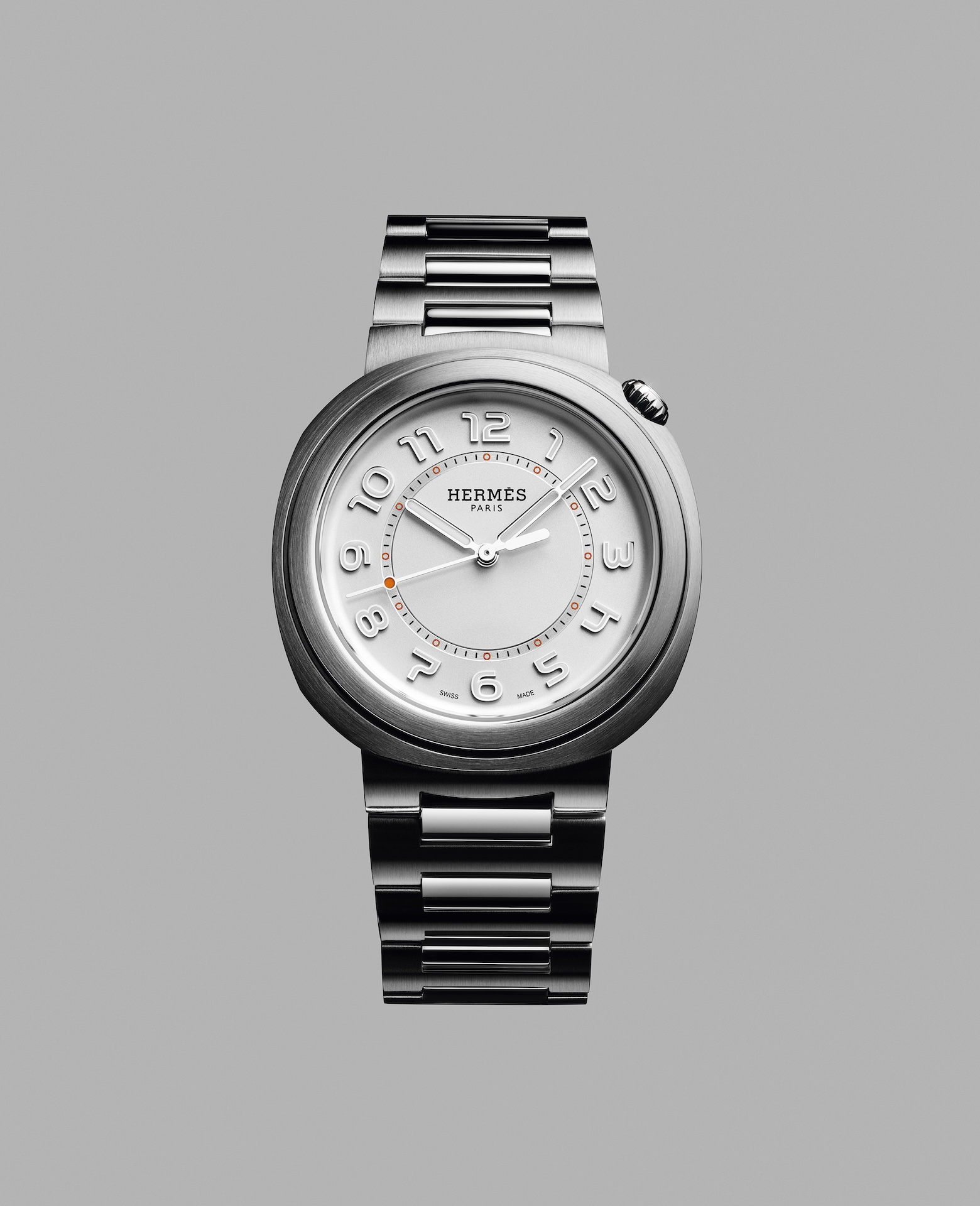
Moving away from the block colours and sporty aesthetic that has defined Hermès watches in recent years, the biggest news from the French luxury goods company at Watches & Wonders came with the unveiling of its newest collection, the Hermès Cut.
It flaunts a round bezel, but the case middle is nearer to a tonneau shape—a relatively simple design that, despite attracting flak from some watch aficionados, works. While marketed as a “women’s watch”, the Cut has universal appeal thanks to its elegant package and proportions. It moves away from the Maison’s penchant for a style-first product; it’s a watch that tells the time, not a fashion accessory with the ability to tell the time.
Hermès gets the proportions just right thanks to a satin-brushed and polished 36 mm case, PVD-treated Arabic numerals, and clean-cut edges that further accentuate its character. One of the key design elements is the positioning of the crown, boldly sitting at half-past one and embellished with a lacquered or engraved “H”, clearly stamping its originality. The watch is powered by a Hermès Manufacture movement H1912, revealed through its sapphire crystal caseback. In addition to its seamlessly integrated and easy-wearing metal bracelet, the Cut also comes with the option for a range of coloured rubber straps. Together with its clever interchangeable system, it’s a cinch to swap out its look.
It will be interesting to see how the Hermès Cut fares in coming months, particularly as it tries to establish its own identity separate from the more aggressive, but widely popular, Ho8 collection. Either way, the company is now a serious part of the dialogue around the concept of time.
—
Read more about this year’s Watches & Wonders exhibition at robbreport.com.au
You may also like.
22/07/2024
Living La Vida Lagerfeld
The world remembers him for fashion. But as a new tome reveals, the iconoclastic designer is defined as much by extravagant, often fantastical, homes as he is clothes.
“Lives, like novels, are made up of chapters”, the world-renowned bibliophile, Karl Lagerfeld, once observed.
Were a psychological-style novel ever to be written about Karl Lagerfeld’s life, it would no doubt give less narrative weight to the story of his reinvigoration of staid fashion houses like Chloe, Fendi and Chanel than to the underpinning leitmotif of the designer’s constant reinvention of himself.
In a lifetime spanning two centuries, Lagerfeld made and dropped an ever-changing parade of close friends, muses, collaborators and ambiguous lovers, as easily as he changed his clothes, his furniture… even his body. Each chapter of this book would be set against the backdrop of one of his series of apartments, houses and villas, whose often wildly divergent but always ultra-luxurious décor reflected the ever-evolving personas of this compulsively public but ultimately enigmatic man.
With the publication of Karl Lagerfeld: A Life in Houses these wildly disparate but always exquisite interiors are presented for the first time together as a chronological body of work. The book indeed serves as a kind of visual novel, documenting the domestic dreamscapes in which the iconic designer played out his many lives, while also making a strong case that Lagerfeld’s impact on contemporary interior design is just as important, if not more so, than his influence on fashion.
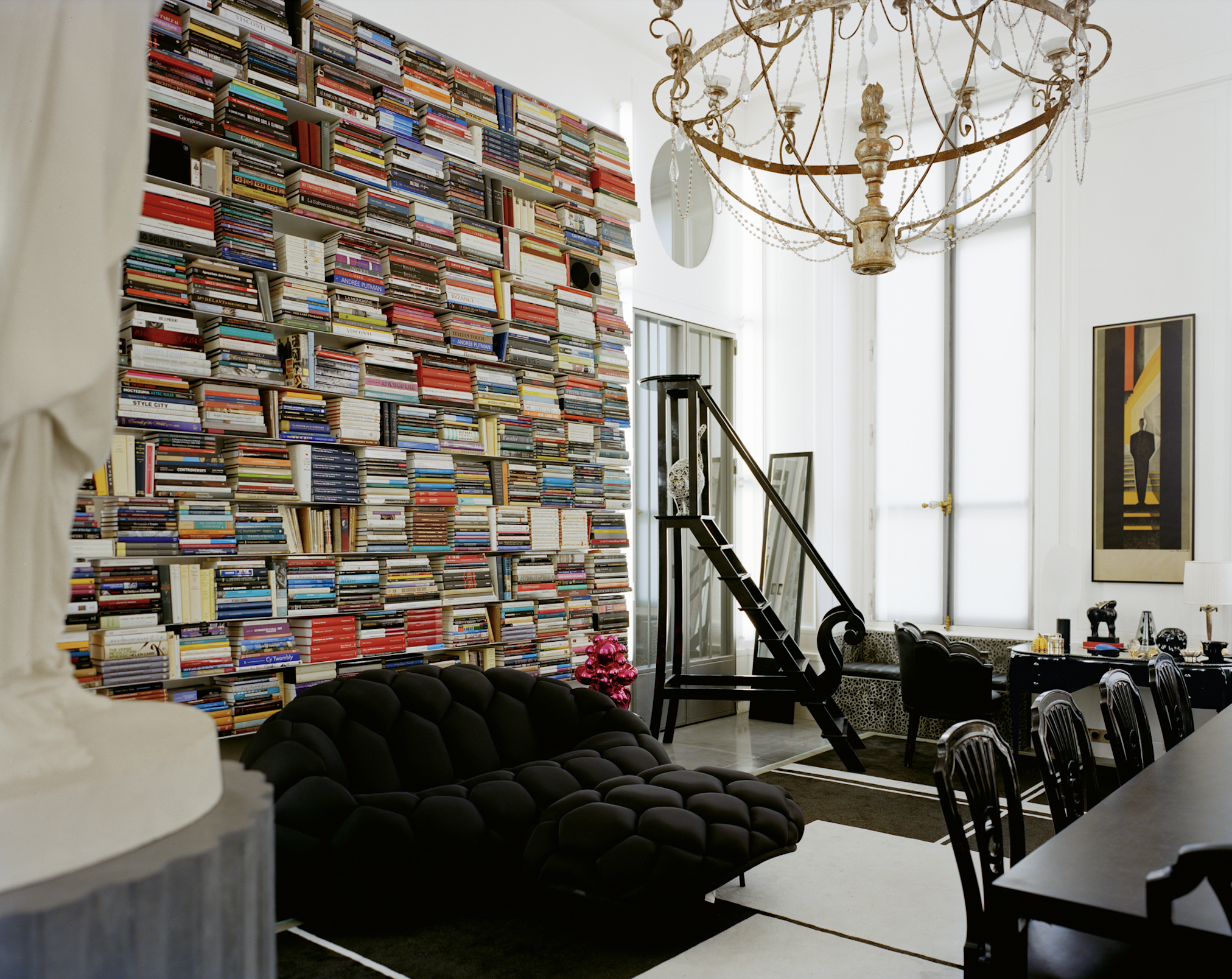
In fact, when the first Lagerfeld interior was featured in a 1968 spread for L’OEil magazine, the editorial describes him merely as a “stylist”. The photographs of the apartment in an 18th-century mansion on rue de Université, show walls lined with plum-coloured rice paper, or lacquered deepest chocolate brown in sharp contrast to crisp, white low ceilings that accentuated the horizontality that was fashionable among the extremely fashionable at the time. Yet amid this setting of aggressively au courant modernism, the anachronistic pops of Art Nouveau and Art Deco objects foreshadow the young Karl’s innate gift for creating strikingly original environments whose harmony is achieved through the deft interplay of contrasting styles and contexts.
Lagerfeld learned early on that presenting himself in a succession of gem-like domestic settings was good for crafting his image. But Lagerfeld’s houses not only provided him with publicity, they also gave him an excuse to indulge in his greatest passion. Shopping!
By 1973, Lagerfeld was living in a new apartment at Place Saint–Sulpice where his acquisition of important Art Deco treasures continued unabated. Now a bearded and muscular disco dandy, he could most often be found in the louche company of the models, starlets and assorted hedonistic beauties that gathered around the flamboyant fashion illustrator Antonio Lopez. Lagerfeld was also in the throes of a hopeless love affair with Jacques de Bascher whose favours he reluctantly shared with his nemesis Yves Saint Laurent.
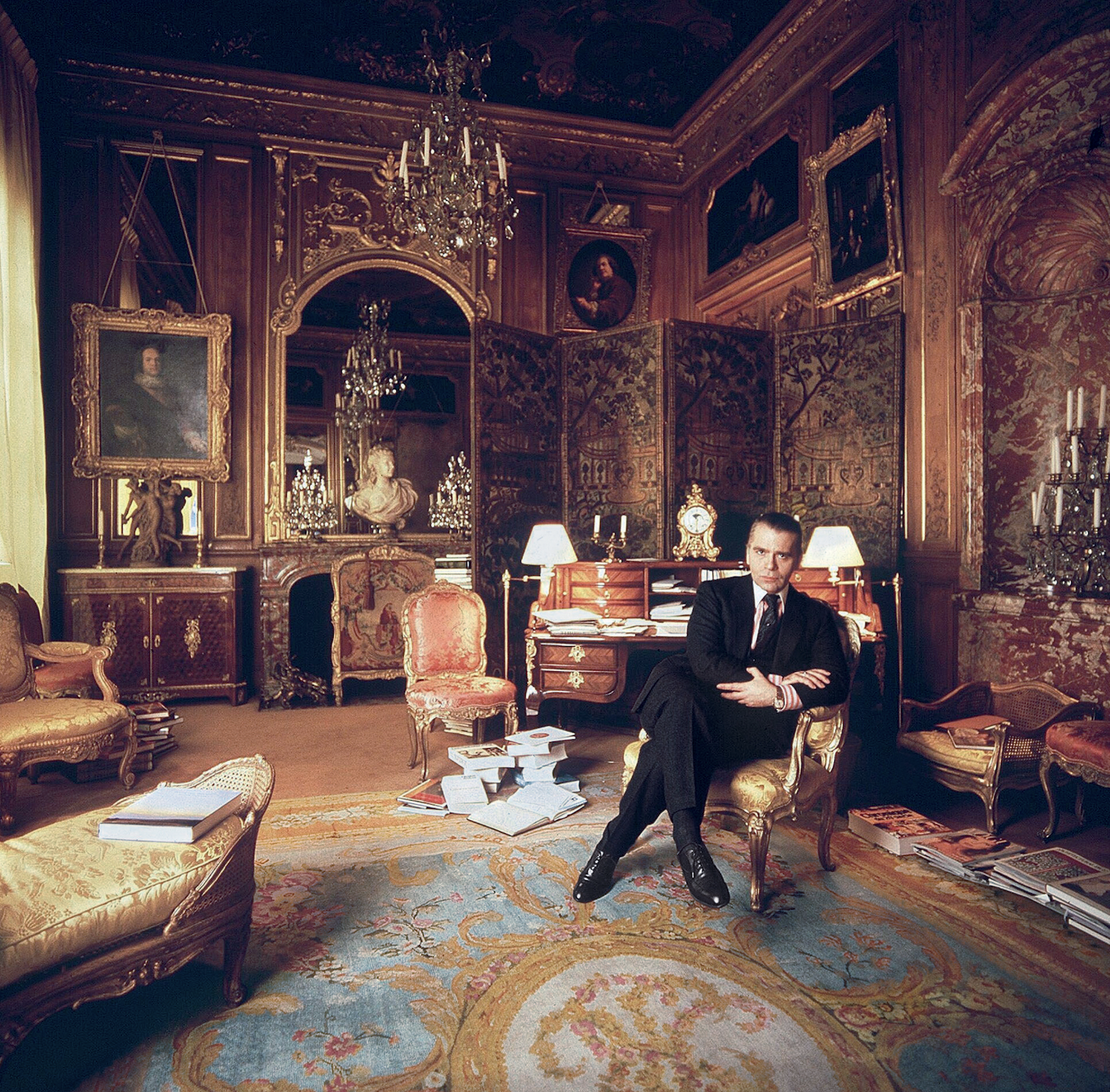
He painted the rooms milky white and lined them with specially commissioned carpets—the tawny patterned striations of which invoked musky wild animal pelts. These lent a stark relief to the sleek, machine-age chrome lines of his Deco furnishings. To contemporary eyes it remains a strikingly original arrangement that subtly conveys the tensions at play in Lagerfeld’s own life: the cocaine fuelled orgies of his lover and friends, hosted in the pristine home of a man who claimed that “a bed is for one person”.
In 1975, a painful falling out with his beloved Jacques, who was descending into the abyss of addiction, saw almost his entire collection of peerless Art Deco furniture, paintings and objects put under the auctioneer’s hammer. This was the first of many auction sales, as he habitually shed the contents of his houses along with whatever incarnation of himself had lived there. Lagerfeld was dispassionate about parting with these precious goods. “It’s collecting that’s fun, not owning,” he said. And the reality for a collector on such a Renaissance scale, is that to continue buying, Lagerfeld had to sell.
Of all his residences, it was the 1977 purchase of Hôtel Pozzo di Borgo, a grand and beautifully preserved 18th-century house, that would finally allow him to fulfill his childhood fantasies of life in the court of Madame de Pompadour. And it was in this aura of Rococó splendour that the fashion designer began to affect, along with his tailored three-piece suits, a courtier’s ponytailed and powdered coif and a coquettish antique fan: marking the beginning of his transformation into a living, breathing global brand that even those with little interest in fashion would immediately recognise.
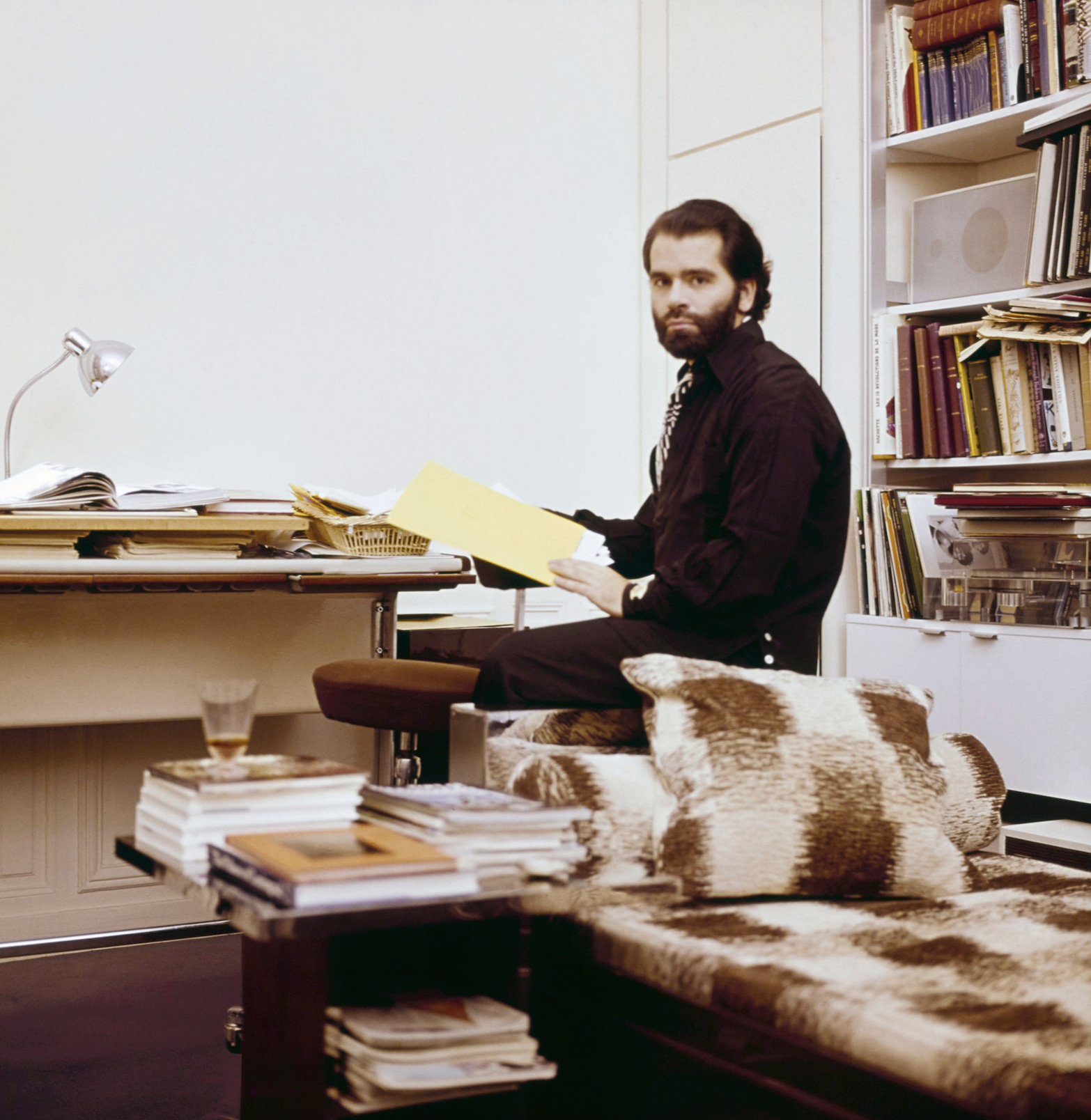
Lagerfeld’s increasing fame and financial success allowed him to indulge in an unprecedented spending frenzy, competing with deep-pocketed institutions like the Louvre to acquire the finest, most pedigreed pearls of the era—voluptuously carved and gilded bergères; ormolu chests; and fleshy, pastel-tinged Fragonard idylls—to adorn his urban palace. His one-time friend André Leon Talley described him in a contemporary article as suffering from “Versailles complex”.
However, in mid-1981, and in response to the election of left-wing president, François Mitterrand, Lagerfeld, with the assistance of his close friend Princess Caroline, became a resident of the tax haven of Monaco. He purchased two apartments on the 21st floor of Le Roccabella, a luxury residential block designed by Gio Ponti. One, in which he kept Jacques de Bascher, with whom he was now reconciled, was decorated in the strict, monochromatic Viennese Secessionist style that had long underpinned his aesthetic vocabulary; the other space, though, was something else entirely, cementing his notoriety as an iconoclastic tastemaker.
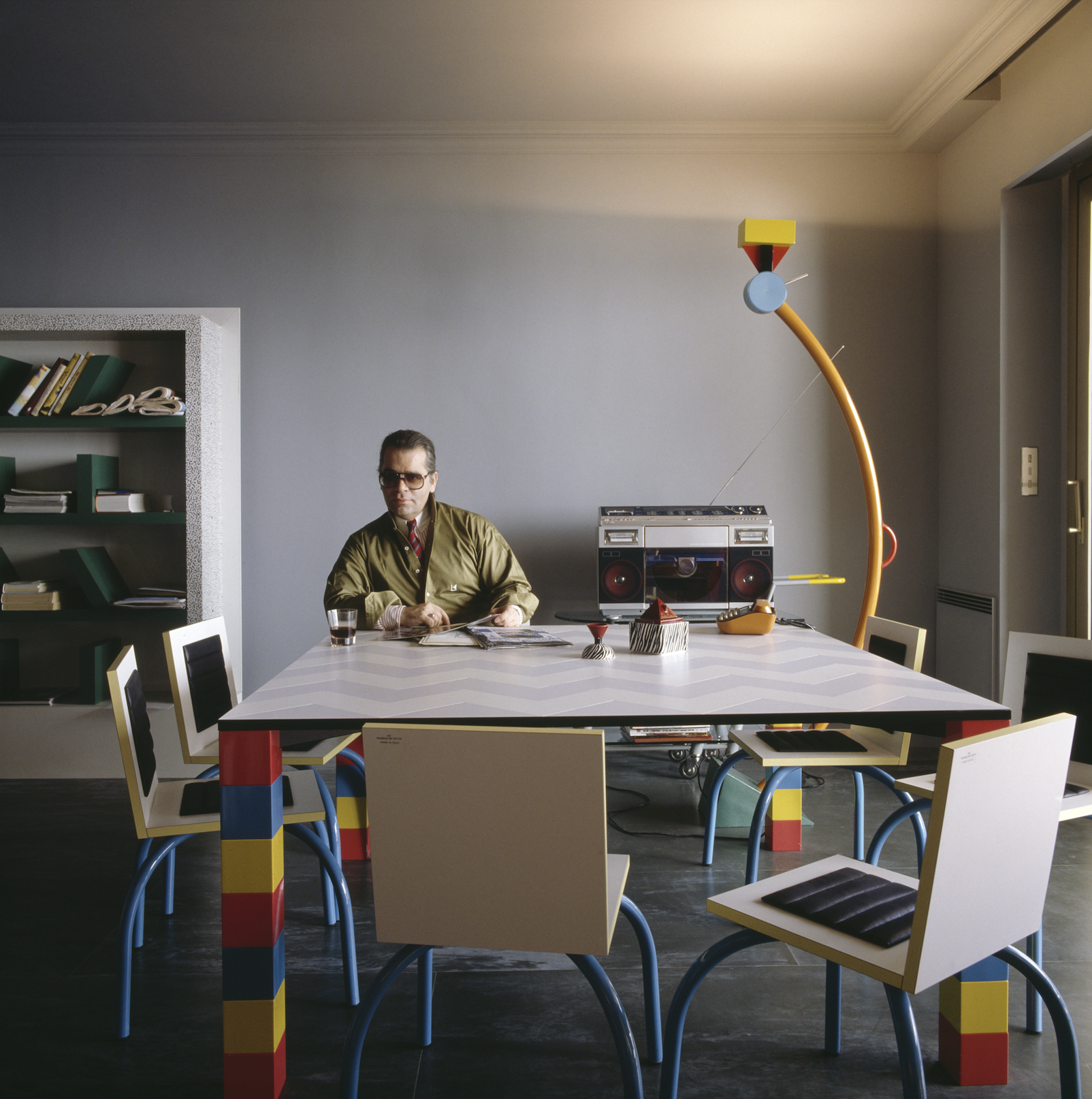
Lagerfeld had recently discovered the radically quirky designs of the Memphis Group led by Ettore Sottsass, and bought the collective’s entire first collection and had it shipped to Monaco. In a space with no right angles, these chaotically colourful, geometrically askew pieces—centred on Masanori Umeda’s famous boxing ring—gave visitors the disorientating sensation of having entered a corporeal comic strip. By 1991, the novelty of this jarring postmodern playhouse had inevitably worn thin and once again he sent it all to auction, later telling a journalist that “after a few years it was like living in an old Courrèges. Ha!”
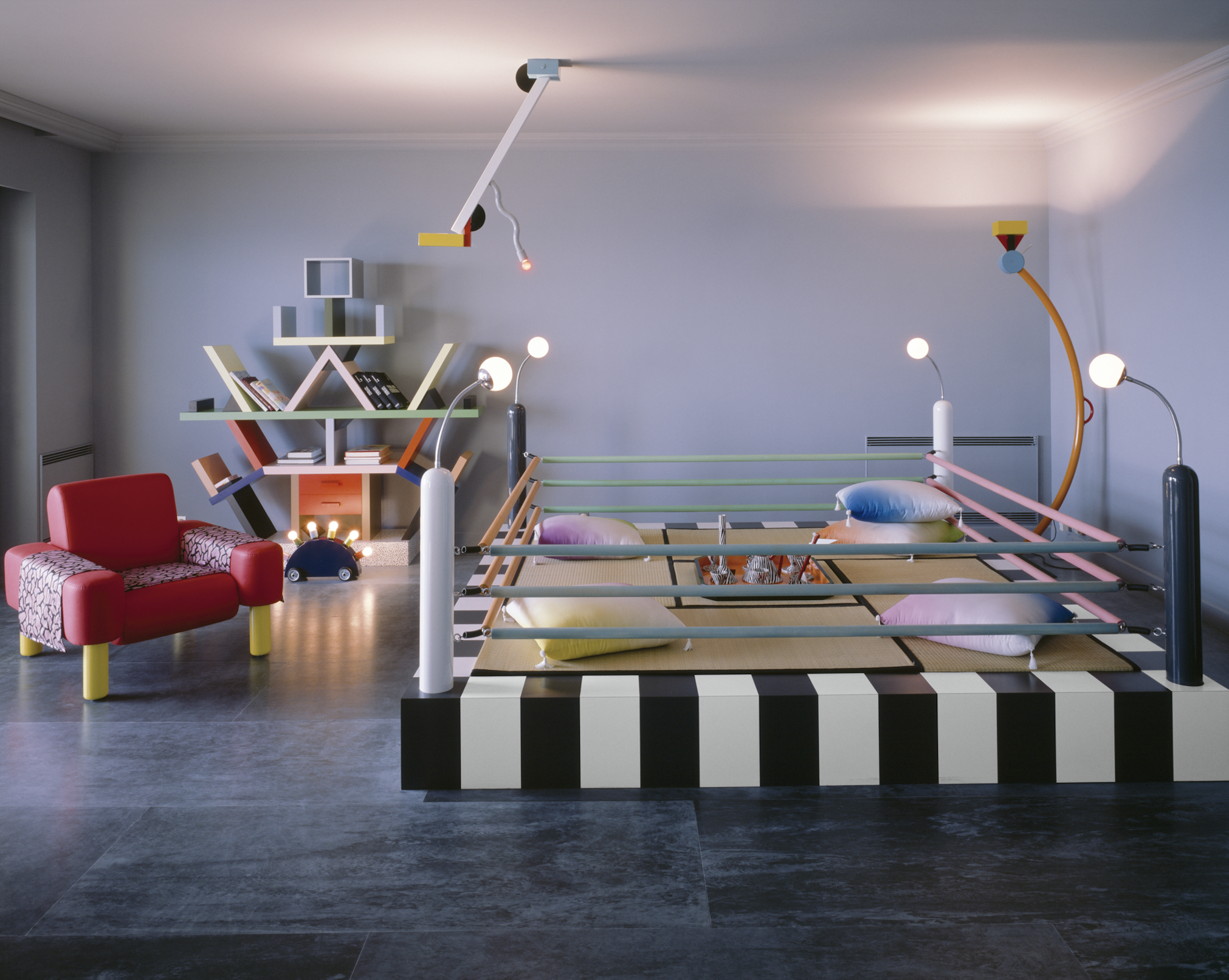
In 1989, de Bascher died of an AIDS-related illness, and while Lagerfeld’s career continued to flourish, emotionally the famously stoic designer was struggling. In 2000, a somewhat corpulent Lagerfeld officially ended his “let them eat cake” years at the Hôtel Pozzo di Borgo, selling its sumptuous antique fittings in a massive headline auction that stretched over three days. As always there were other houses, but now with his longtime companion dead, and his celebrity metastasising making him a target for the paparazzi, he began to look less for exhibition spaces and more for private sanctuaries where he could pursue his endless, often lonely, work.
His next significant house was Villa Jako, named for his lost companion and built in the 1920s in a nouveau riche area of Hamburg close to where he grew up. Lagerfeld shot the advertising campaign for Lagerfeld Jako there—a fragrance created in memorial to de Bascher. The house featured a collection of mainly Scandinavian antiques, marking the aesthetic cusp between Art Nouveau and Art Deco. One of its rooms Lagerfeld decorated based on his remembrances of his childhood nursery. Here, he locked himself away to work—tellingly—on a series of illustrations for the fairy tale, The Emperor’s New Clothes. Villa Jako was a house of deep nostalgia and mourning.
But there were more acts—and more houses—to come in Lagerfeld’s life yet. In November 2000, upon seeing the attenuated tailoring of Hedi Slimane, then head of menswear at Christian Dior, the 135 kg Lagerfeld embarked on a strict dietary regime. Over the next 13 months, he melted into a shadow of his former self. It is this incarnation of Lagerfeld—high white starched collars; Slimane’s skintight suits, and fingerless leather gloves revealing hands bedecked with heavy silver rings—that is immediately recognisable some five years after his death.
The 200-year-old apartment in Quái Voltaire, Paris, was purchased in 2006, and after years of slumber Lagerfeld—a newly awakened Hip Van Winkle—was ready to remake it into his last modernist masterpiece. He designed a unique daylight simulation system that meant the monochromatic space was completely without shadows—and without memory. The walls were frosted and smoked glass, the floors concrete and silicone; and any hint of texture was banned with only shiny, sleek pieces by Marc Newson, Martin Szekely and the Bouroullec Brothers permitted. Few guests were allowed into this monastic environment where Lagerfeld worked, drank endless cans of Diet Coke and communed with Choupette, his beloved Birman cat, and parts of his collection of 300,000 books—one of the largest private collections in the world.
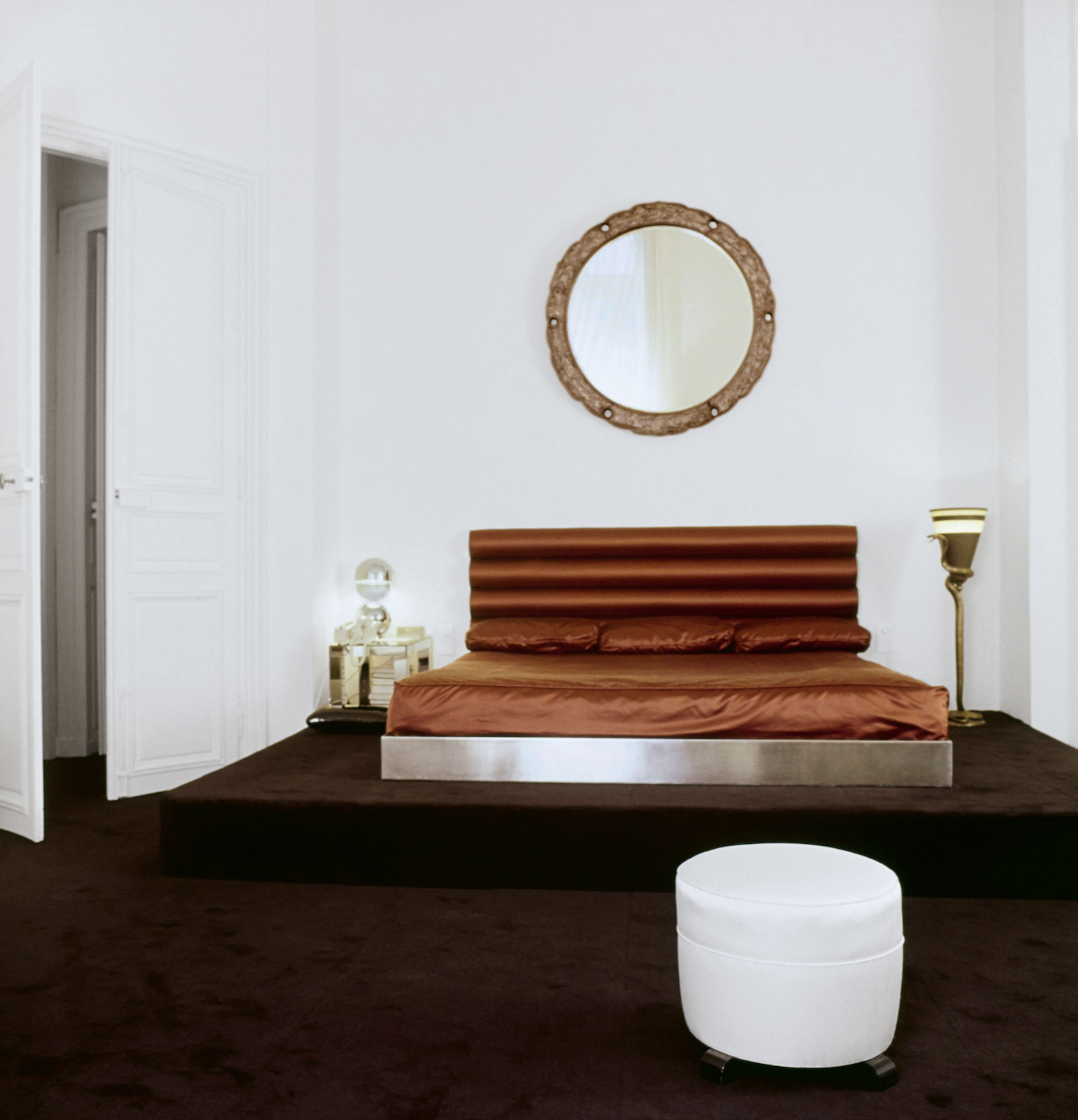
Lagerfeld died in 2019, and the process of dispersing his worldly goods is still ongoing. The Quái Voltaire apartment was sold this year for US$10.8 million (around $16.3 million). Now only the rue de Saint-Peres property remains within the Lagerfeld trust. Purchased after Quái Voltaire to further accommodate more of his books—35,000 were displayed in his studio alone, always stacked horizontally so he could read the titles without straining his neck—and as a place for food preparation as he loathed his primary living space having any trace of cooking smells. Today, the rue de Saint-Peres residence is open to the public as an arts performance space and most fittingly, a library.
You may also like.
By Josh Bozin
24/07/2024
Watch This Space: Mike Nouveau
Meet the game-changing horological influencers blazing a trail across social media—and doing things their own way.
In the thriving world of luxury watches, few people own a space that offers unfiltered digital amplification. And that’s precisely what makes the likes of Brynn Wallner, Teddy Baldassarre, Mike Nouveau and Justin Hast so compelling.
These thought-provoking digital crusaders are now paving the way for the story of watches to be told, and shown, in a new light. Speaking to thousands of followers on the daily—mainly via TikTok, Instagram and YouTube—these progressive commentators represent the new guard of watch pundits. And they’re swaying the opinions, and dollars, of the up-and-coming generations who now represent the target consumer of this booming sector.
—
MIKE NOUVEAU
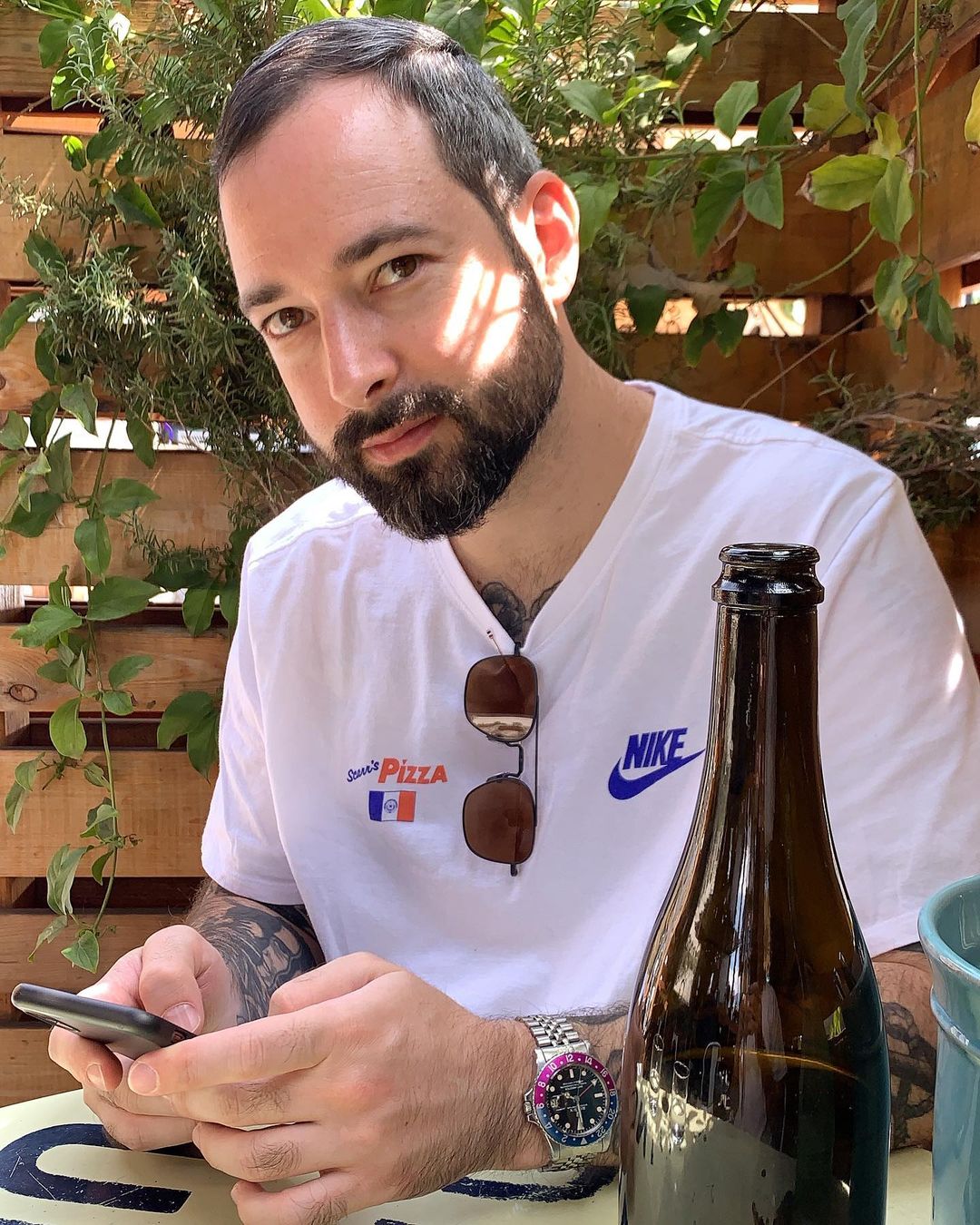
Can we please see what’s on the wrist? That’s the question that catapulted Mike Nouveau into watch stardom, thanks to his penchant for highlighting incredibly rare timepieces across his TikTok account of more than 400,000 followers. When viewing Nouveau’s attention-grabbing video clips—usually shot in a New York City neighbourhood—it’s not uncommon to find him wrist-rolling some of the world’s rarest timepieces, like the million-dollar Cartier Cheich (a clip he posted in May).
But how did someone without any previous watch experience come to amass such a cult following, and in the process gain access to some of the world’s most coveted timepieces? Nouveau admits had been a collector for many years, but moved didn’t move into horology full-time until 2020, when he swapped his DJing career for one as a vintage watch specialist.
“I probably researched for a year before I even bought my first watch,” says Nouveau, alluding to his Rolex GMT Master “Pepsi” ref. 1675 from 1967, a lionised timepiece in the vintage cosmos. “I would see deals arise that I knew were very good, but they weren’t necessarily watches that I wanted to buy myself. I eventually started buying and selling, flipping just for fun because I knew how to spot a good deal.”
Nouveau claims that before launching his TikTok account in the wake of Covid-19, no one in the watch community knew he existed. “There really wasn’t much watch content, if any, on TikTok before I started posting, especially talking about vintage watches. There’s still not that many voices for vintage watches, period,” says Nouveau. “It just so happens that my audience probably skews younger, and I’d say there are just as many young people interested in vintage watches as there are in modern watches.”
View this post on Instagram
Nouveau recently posted a video to his TikTok account revealing that the average price of a watch purchased by Gen Z is now almost US$11,000 (around $16,500), with 41 percent of them coming into possession of a luxury watch in the past 12 months.
“Do as much independent research as you can [when buying],” he advises. “The more you do, the more informed you are and the less likely you are to make a mistake. And don’t bring modern watch expectations to the vintage world because it’s very different. People say, ‘buy the dealer’, but I don’t do that. I trust myself and myself only.”
—
Read more about the influencers shaking up horology here with Justin Hast, Brynn Wallner and Teddy Baldassare.
You may also like.
By Josh Bozin
24/07/2024
This Pristine 1960 Ferrari 250 Spider Could Fetch $24 Million at Auction
The car wears the same colours and has the same engine it left the factory with.
Some Ferraris are just a little bit more important than others.
Take, for example, the 1960 250 GT SWB California that RM Sotheby’s is auctioning off during this year’s Monterey Car Week. Any example of the open-top beauty would attract interest, but this one just so happens to be the first one that was built.
The 250 is one of the most legendary series of cars in Ferrari history. Between 1952 and 1964, the company released 21 different 250 models—seven for racetracks, 14 for public roads—of which the “Cali Spider” might be the most well regarded, thanks to its potent V-12 and a Pininfarina-penned design that is one of the most beautiful bodies to grace an automobile. The roadster, which was specifically built for the U.S., made its debut in 1957 as a long-wheel-base model (LWB), but it wasn’t until the SWB model debut in 1960 that it became clear how special it was. This example isn’t just the first to roll off the line. It’s the actual car that was used to introduce the world to the model at the 1960 Geneva Motor Show.
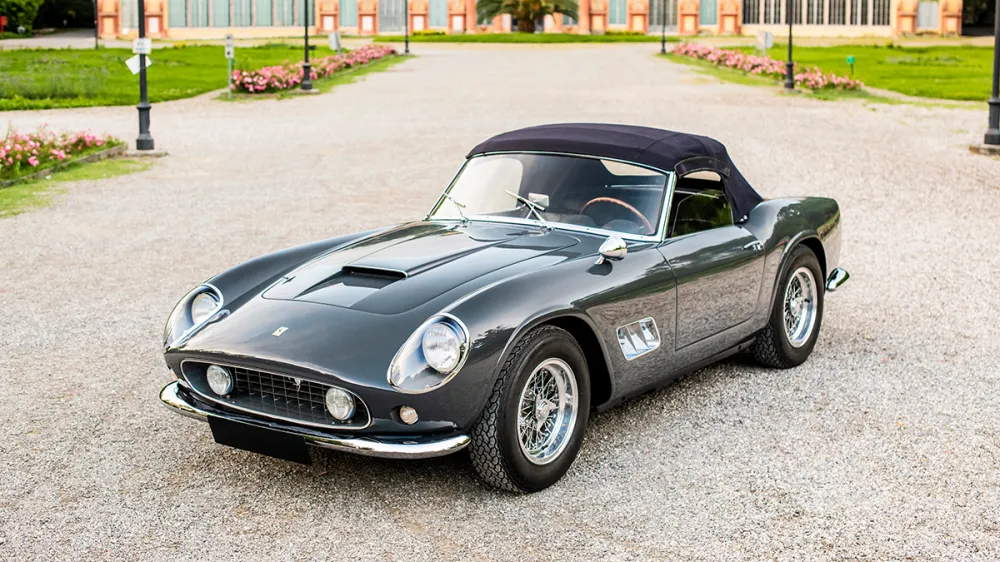
Just 56 examples of the 250 GT SWB California Spider would be built by Scaglietti during the three years it was in production. The first of those, chassis 1795 GT, is finished in a glossy coat of Grigio. The two-door had a red leather interior at Geneva but was returned to the factory and re-outfitted with black leather upholstery before being delivered to its original owner, British race car driver John Gordon Bennet. Six-and-a-half decades later the car looks identical to how it did when it left the factory the second time.
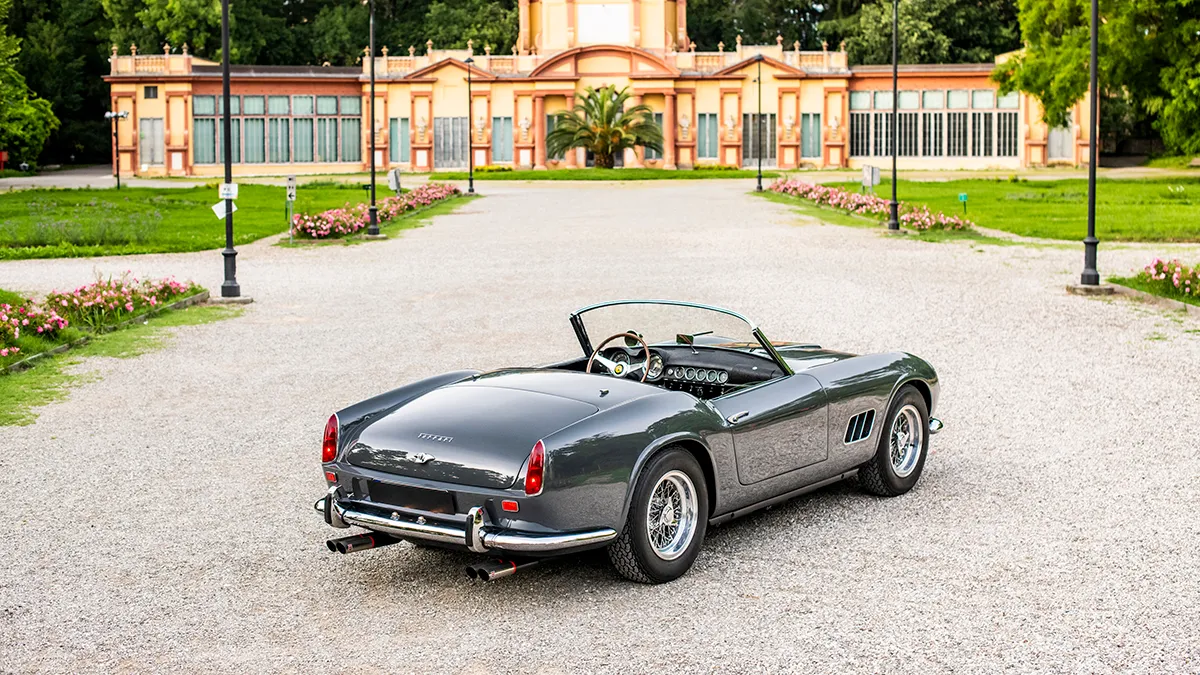
In addition to its original bodywork, the chassis 1795 GT features its original engine, gearbox, and rear axle. That mill is the competition-spec Tipo 168, a 3.0-litre V-12 that makes 196.1 kW. That may not sound like much by today’s standards, but, when you consider that the 250 GT SWB California Spider tips the scales around 952 kilograms, it’s more than enough.
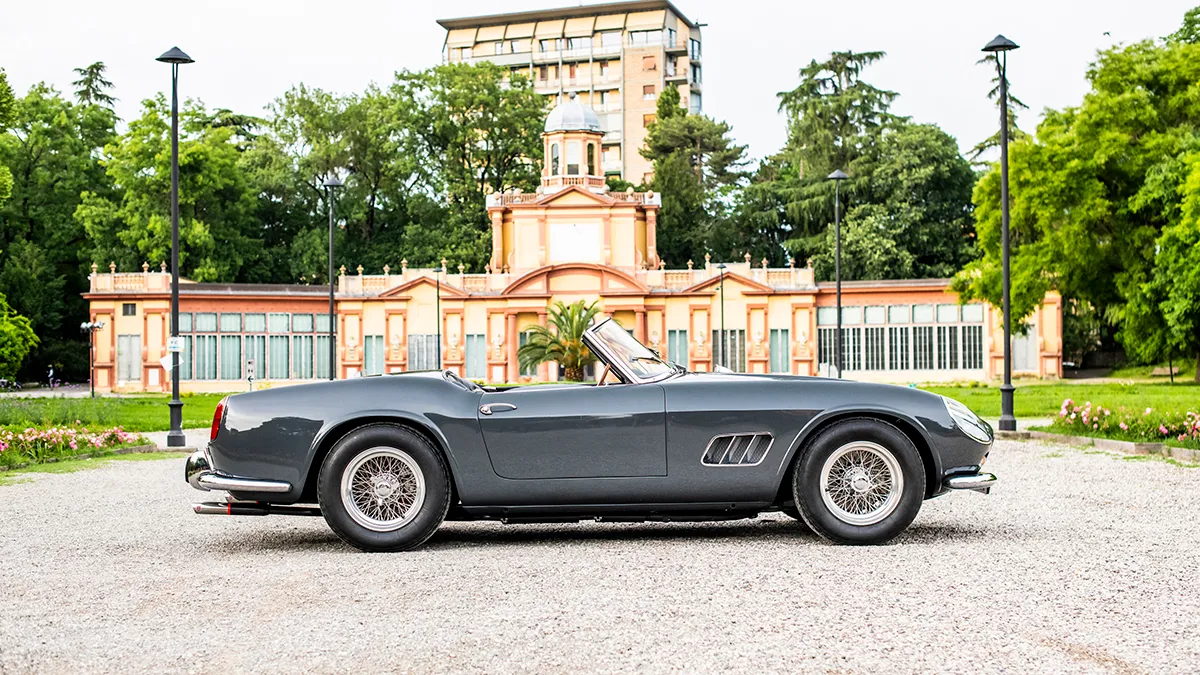
The first 250 GT SWB California Spider is scheduled to go up for bid during RM Sotheby’s annual Monterey Car Week auction, which runs from Thursday, August 15, to Saturday, August 17. Unsurprisingly, the house has quite high hopes for the car. The car carries an estimate of between $24 million and $26 million, which could make it one of the most expensive cars ever sold at auction.
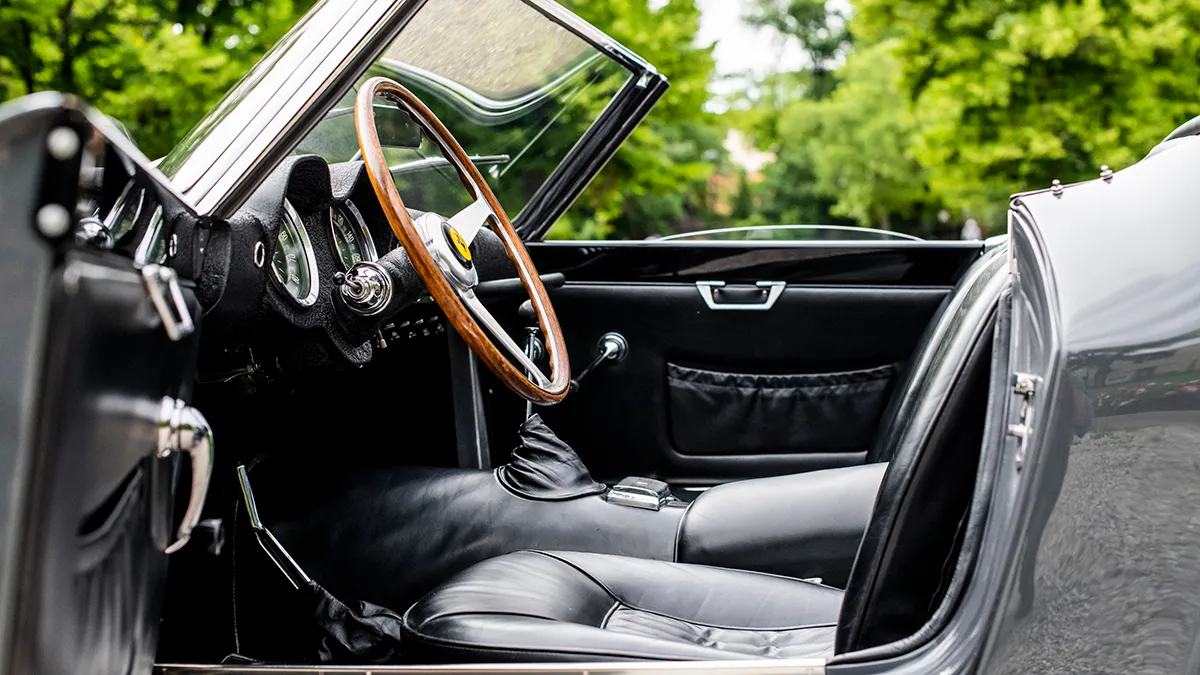
You may also like.
By Josh Bozin
24/07/2024






